 USA (1919-23)- USS Colorado, Maryland, West Virginia
USA (1919-23)- USS Colorado, Maryland, West VirginiaWW1 US Battleships:
USS Maine | USS Texas | Indiana class | USS Iowa | Kearsage class | Illinois class | Maine class | Virginia class | Connecticut class | Mississippi class | South Carolina class | Delaware class | Florida class | Arkansas class | New York class | Nevada class | Pennsylvania class | New Mexico class | Tennessee class | Colorado class | South Dakota class | Lexington classThe Colorado class, formed with the near-sister ships Tennesse what was called the “big five”, the last USN super-dreadnoughts, and last of the “Standards”. To gain time and budget, the Colorado were planned in 1916 as virtual copies of the Tennesse, but with 16-inches guns, first to inaugurate this new main caliber and only ones to have them in twin turrets. They were also the last USN capital ships to that point with a gap of nearly twenty years before the North Carolina class.
Colorado class: The “standards” goes 16-inches

The “Big Five” in exercizes in the mate 1930s
The main point to identify the Colorado class* were the fact they were the first to adopt 16-inches guns, while the “Standards”, from the Nevada class (1914) were all given 14 inches guns, generally in four triple turrets. But the Colorado happened to be also the last of the pre-Treaty battleships. They were designed during World War I, which was ongoing at the end of the conflict. By that time, no treaty was sight, so construction went on until launch, in 1920 in its immediate aftermath. Though all four keels were laid, only three ships were launched: Colorado, Maryland, and West Virginia. Washington was over 75% completed when she was canceled under the terms of the Washington Naval Treaty in 1922. As such, the 16″ gun Colorado-class ships were the last and most powerful battleships built by the U.S. Navy until the North Carolina class entered service on the eve of World War II.
The Colorados were the final group of the Standard-type battleships, designed to have similar speed and handling to simplify maneuvers with the line of battle. The cancelled South Dakota class which was to follow would have in several ways been a departure from this practice. Apart from an upgrade in striking power with their eight 16-inch guns, the Colorados were essentially repeats of the earlier Tennessee class. The Colorados were also the last American capital ships built with four main armament turrets and twin-mounted guns. The change to larger guns was prompted by the Japanese Nagato-class battleships, which also mounted eight 16-inch guns.
All three ships participated in World War II, athough it started badly: USS Maryland and West Virginia were both damaged in Pearl Harbor on 7 December 1941. Maryland was relatively unscathed, but West Virginia was sunk. She was later raised, and not only repaired but fully modenrized. All three battleships brought naval gunfire during the island hoping campaign of 1943-45. USS Maryland and West Virginia was also at the Battle of Surigao Strait (Battle of Leyte Gulf) in October 1944. In all, they won 19 (7+7+5) battle stars combined for their wartime service. None was preserved after the war.
*Note: It is sometimes referred to as “Maryland class”. US is about the launching date, but European conventions name a class after the first unit completed, so Maryland here.
Context before the Colorado class

The stip to 16-inch guns was envisioned by the General Board and Bureau of Construction and Repair (C&R) in 1913 already, to keep pace with the British notably, an upgrade that would allow twice the kinetic energy compared to 12-inch and 50% more than the current 14-inch just being introduced. The development of the new gun was postponed however at least until 1916, due to design issues. The General Board initially approved development of 16-inch gun as early as 1911. By that time however, Navy secretary George von Lengerke Meyer feared that such capital ships would make obsolete overnight all the others still on the drawing board. He restricted the Bureau of Ordnance to go beyond the delivery of blueprints, kept “in store” in case of new foreign developments.
He approved eventually the construction of the new gun in October 1912. R&D progressed steadily until a prototype was ready and tested. It fired successfully in August 1914. Meanwhile, the admiralty get wind of unofficial, unconfirmed reports of 15/16-inch guns adopted by the United Kingdom, but Italy, Germany and Japan for their own programmes. The Board even considered cancelling the construction of the Pennsylvania class for an up-gunned version, calculated to increase 8,000 tons the displacement. Debate went on as the war starte and progress while Woodrow Wilson’s Navy Secretary Josephus Daniels, considered the increase in cost and insisted on the Standard Class to be continued. In 1917 as it was clear the US would be likely engaged in the conflict, he temporized and accepted a simple repeat of the previous class but with an armament upgrade. This constrained engineers to make choices right away.
Design development
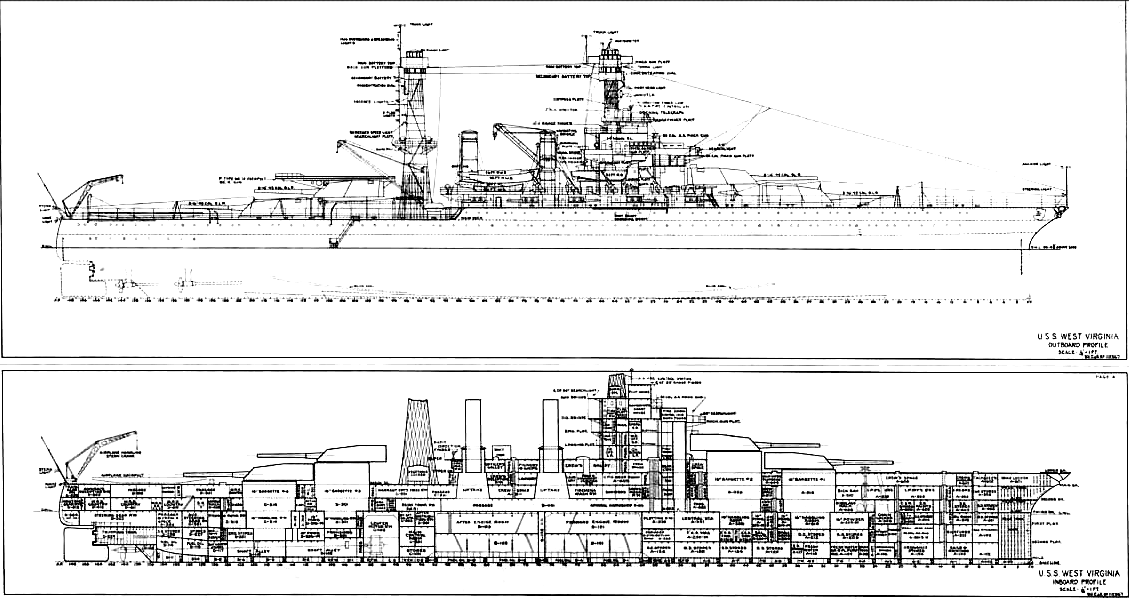
The design of the Colorado class proceeded fast, based on the fact it was a repeat of the Tennessee class, with only the main armament changing. Fitting eight 16 in (406 mm)/45 caliber guns in four twin turrets in place of twelve 14 in (356 mm)/50 guns in triple turrets was a daunting task however, but less costly and complicated than going for a new revised design (which was to be the wartime South dakota class, much larger). Other than this, the two designs were near identical. The Tennessees were basically improved New Mexico, modern and effective capital ships in 1917, the most modern at the time, which also attracted the attention of British constructors. Commonality and mass production became ans essential wartime experience and the U.S. Navy by just keeping these standards almost created battleships “on an assembly line” with maximal standardization and rationalization to keep the costs low. The Naval Act of 1916 indeed planned 16 battleships and six battlecruisers, so streamlining production was the only way to save time and money.
However despite this, engineers were able to bring design improvements at each iteration, incorporating innovation whenever practicable. For the Tennessee however, the underwater protection, projectiles landing underneath the waterline was late to be designed and tested, in fact too late as construction was ongoing. Tests in caissons took time, and the modifications concerned the very bottom of the ship, so cannot be implemented on time without delayiong construction. Tests were allow to continue on the behalf they would be adopted for the next class. These would prove that a series of compartments divided by liquid filling, others left empty in alternance proved to be the most effective protection against torpedoes. C&R then added a contract clause for the next ships sent to shipbuilding corporations that alterations to the design would be asked within three months after their keels were laid down.
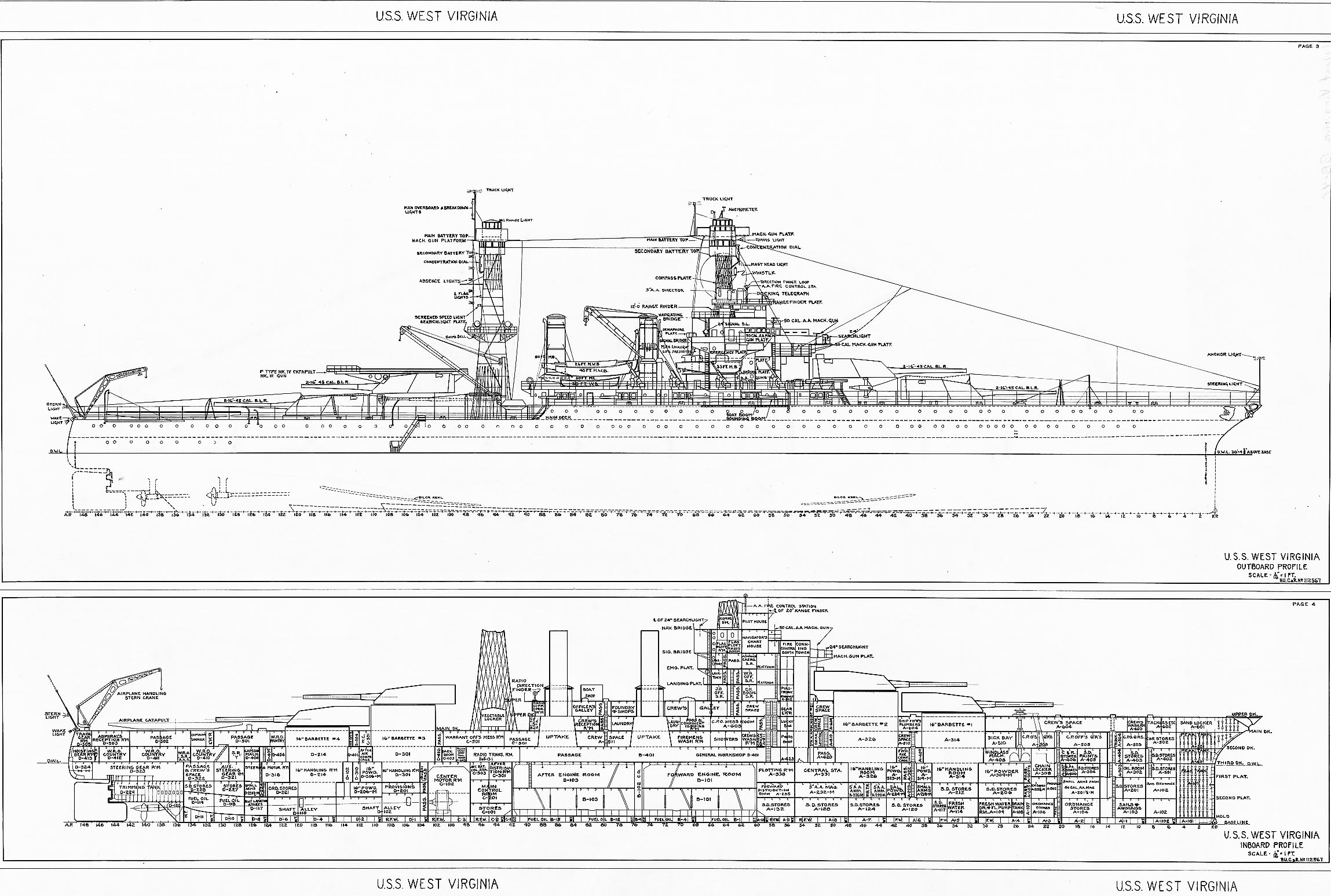
General Characteristics
The hull designed was the same in all its details, 624-foot (190 m) long overall, 97 feet (30 m) in beam for a design displaced of 32,600 long tons (33,100 t) -normal load- or 33,590 long tons (34,130 t) deeply loaded, for 30.5 feet (9.3 m) draft. Since the New mex. she was the design incorporated a clipper bow to deal with heavy heavy seas, while the secondary armament was in the superstructure to avoid water spray also in heavy seas.
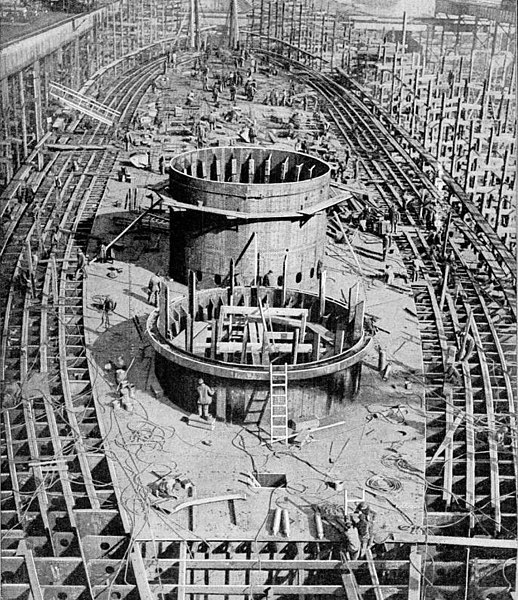
Powerplant
Like the previous Tennessee, the Colorado class adopted the ame innovative Turbo-electric transmission. Its advantages included for the turbines an optimum speed without regard to propeller speed, and greater fuel efficiency for a better range, as well as a more sustained, easier sub-division to deal with torpedo hits. Each propeller shaft was driven by a 5,424 kilowatt electric motor, in turn fed by two two-phase turbo generators each, from General Electric for Maryland and Westinghouse for Colorado and West Virginia, each rated at 5,000 volts. In turn these generators fed by turbines were connected to eight oil-fired Babcock & Wilcox water-tube boilers with their individual compartments. Toal output was rated for 28,900 electrical horsepower, giving a theoretical top speed of 21 knots (39 km/h; 24 mph). The ships also carried an optimized fuel tank distribution (participating notably in ASW protection as damping fluid), for a total of 4,570 tons: The overall range was a well rounded 10,000 nautical miles (19,000 km; 12,000 mi) by keeping a steady cruise speed.
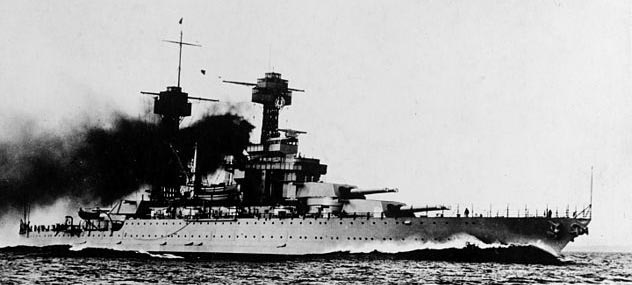
USS Colorado on sea trials
Armour protection
The “all or nothing” armor scheme (inherited from the Nevada-class) was kept, and overall identical to the preceding Tennessee class. There was only one exception though: An increase in belt armor near the machinery, reaching 16 inches (406 mm) in part with the main gun caliber the Colorado carried. Otherwise it stayed at 14 inches. The upper deck armor reached 3.6 inches (91 mm), but it was later increased during constructon to 4.1 inches (104 mm). The lower deck armor was comprised between 2.25 and 1.5 inches and also strengthened later.
The other improvements of the design were also from the Tennessee class, the forward torpedo room moved away from the 16-inch gun magazine, seen as vulnerable. There was also an external rather than internal belt armor to avoid a break in the continuity of the side structure, minimizing drag as well.
Armament
The main challenge for the engineers was to manage to keep as many as the old design (like the basic turret baskets) and even turrets and barbettes while only chanhing the internal of the barbettes, mounts, and loading systems for the new 16-in shells and barrels. This was done to speed up the design phase and launched the construction asap.
Main:
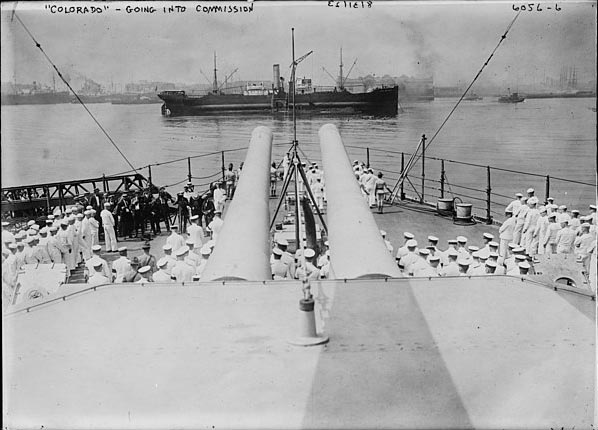
USS Colorado main guns, seen from the bridge, as freshly commissioned in 1922.
As said above, the ain advantage of the Colorado class was their more powerful broadise of eight 16-in guns. They trade four guns for a long range a greater punch and that was considered enough to overcome the fact these ships were a disruption in the “standard” battle line pattern based on the fact similar ships were easier to manage in a battle. Development of the new gun started in August 1913, by simply boring-out, relining a 13-inch (330 mm) Mark 2 gun. It was estimated two times the muzzle energy of a 12-inch (305 mm)/50 caliber Mark 7, and still 50% more than the 14-inch/45. Proof firing in July 1914 was successful, and minor changes were made and work was finalized on the recoil and breech block mechanism so as the 16-inch Mark 1 was eventually ready in May 1916, production approved in January 1917. Four years is a long proces indeed.
Specs of the 16-inch (406 mm)/45 caliber Mark 1:
- 2,110-pound (960 kg) armor-piercing (AP) shell)
- Muzzle velocity 2,600 feet per second (790 m/s)
- Rate of 1.5 rounds per minute
- Max. Range 34,300 yards (31,400 m) at 30 degrees.
Secondary:
Like on the previous ships, the Colorado had Fourteen 5-inch (127 mm)/51 caliber Mark 15 guns installed in the superstructure. This was down to 12 in 1922.
- 50 Ibs (23 kg) shell
- Muzzle velocity 3,150 feet per second (960 m/s)
- Maximum range 15,850 yards (14.5 km)/20°
- Rate of fire seven rounds per minute
These lighter guns compared to the latest British, Japanese and German dreadnoughts were nevertheless very accurate and fast-firing, very deadly beyond the treshold of 3,000 yards (2,700 m). Because of these, they were mounted in unarmored casemates on the main deck.
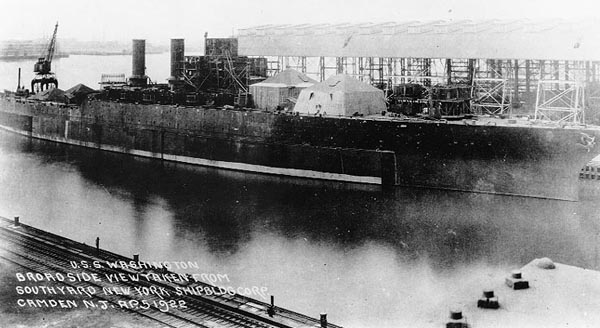
AA armament:
The aviation threat was enough in 1916 to be taken in high regard and having a more AA focused light artillery: This traduced into four 3-inch (76 mm)/23 caliber guns single-mounted purely for anti-aircraft defense (later 8 in 1922).
- 3-inch (76 mm) shell
- Muzzle velocity 1,650 feet per second (500 m/s)
- Maximum range 8,800 yards (8,000 m)
- Ceiling 18,000 feet (5,500 m)
- Elevation 45.3 degrees
- Rate of fire 8-9 rate per minute.

⚙ Specifications 1921 |
|
| Displacement | 32,693 standard 33,590 FL |
| Dimensions | 190 m oa x 29.7m x 9.3m (624 x 97 x 30 feets) |
| Propulsion | 4 shafts GE TED, 8 Babcock & Wilcox boilers, 29,000 shp (21,600 kW) |
| Speed | 21 knots (39 km/h; 24 mph) |
| Range | 8,000 nmi (15,000 km; 9,200 mi) at 10 knots (19 km/h; 12 mph) |
| Armament | 8× 16 in, 16× 5 in, 8× 3 in, 2× 21 in TTs |
| Armor | Belt 8–13.5, barbettes 13, turrets 18, CT 16, decks 3.5 in |
| Crew | 64+1241 |
Interwar Reconstuctions
The modernization of the Tennessee and Colorado classes was not a priority until October 1931. Th Navy indeed thought it was possible to exploit previously spotted loopholes in the Washington Naval Treaty. The treaty indeed allowed both AA defense and ASW protection to be improved at leisure, improve fire control, gun mount elevation, but not for example up-gunning existing ships. Inside the hull everything could be justified as to increase protection, eve, when increasing speed and range, as long as the main armor belt thickness was not modified. It was also envisioned an early “NBC” protection as there was a fear of chemical warfare and the ships being hit by chemical shells with poisonous gas. In that case however, the General Board eventually stated that decontamination was near-impossible and the ship hit wouild have been scuttled.
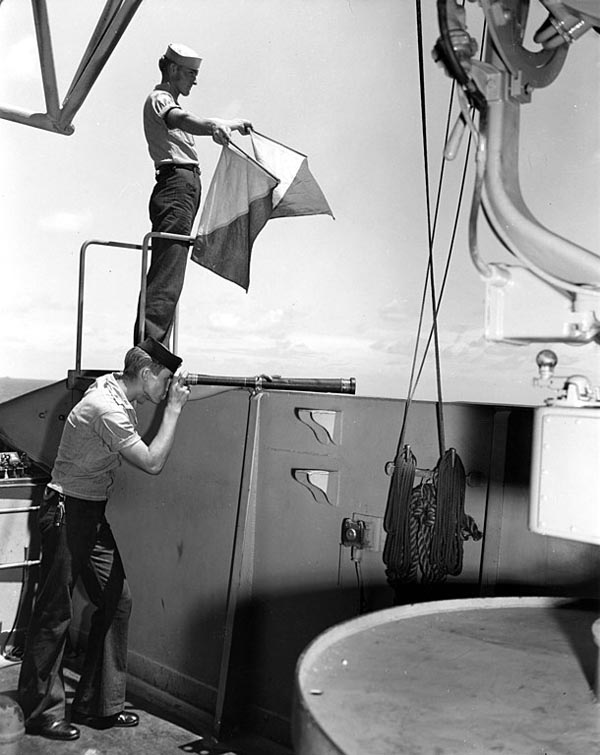
Signalmen anboard USS Colorado
Onboard aviation:
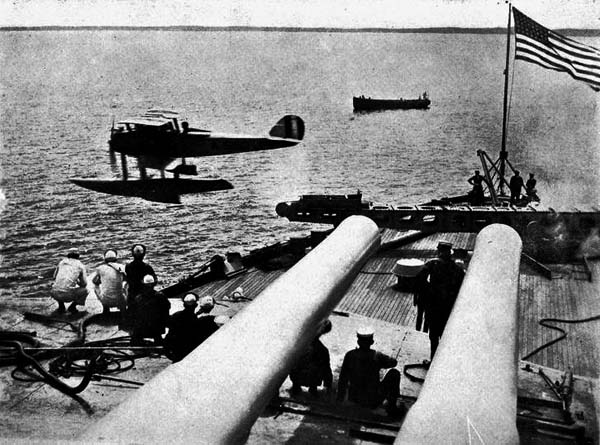
A Curtiss VE-7H catapulted from USS Maryland, 1925.
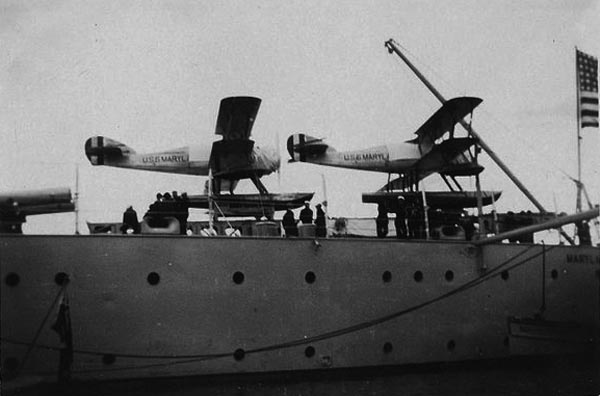
UO-1 seaplanes onboard USS Maryland, 1925.
In the 1920s already, all three ships received catapults for their onboard spotter and reconnaissance aviation, one mounted at the stern, with full traverse (and an operating crane for recovery behind) and another fixed, located on the upper aft turret (N°3). Photos ofter shown what observation plane types were used, two stored on the turret’s catapult and one ready on the aft deck catapult. From 1924 Curtiss VE-7 seaplanes were used, and afterwards the Vought UO-1, then the O3U Corsair. Colorado’s aircraft were assigned to Observation Squadron Four (VO-4) also aboard USS Maryland and West Virginia. The three aircraft aboard Colorado took part in the extensive Earhart search, squadron numbers were 4-O. In the late 1930s, the Curtiss SOC seagull (to be confirmed) until 1940. Indeed, all three ships obtained the Kingfisher afterwards: The OS2U-1’s first operational deployment even commenced on USS Colorado in August 1940. In 1945 refits saw new, more precise and long range radars installed, and seaplanes were generally eliminated while the deck catapult was kept. Photos however of USS West Virginia shows two Curtiss SC Seahawk on board, the last generation USN observation seaplane.
Footage of a Vought Kingfisher launched from USS New Mexico, also showing footage of USS Colorado during the invasion of Guam, July 3, 1944.
Planned upgrades:
Deck armor could be reinforced, and received a 80 lb (36 kg) special treatment steel (STS) plate to deal with incoming high trajectory orounds and bombs, but this move cost 1,319 long tons in displacement (hence in speed and range). It was also planned to up-armor the turret tops. Anti-torpedo bulges for extra buoyancy, dealing with torpedo blasts were considered, provided they will not bring the beam beyond 106 feet (32 m) (Panama-compatible). Another wave concerned all fire controls and optics, and the ballistic computer, as technology advanced well in between. For the guns also, elevation was to be reworked, possibly also the reload speed, the new shells having more propellant and better penetrating caps.
Also, there was a new type of AA for short range that was worked on, traduced into the adoption of quadruple 1.1-inch guns (28 mm), the infamous “Chicago Piano”. Due to all this added weight, it became also necessary to upgrade the machinery no to loose speed, and keep a constant battlefleet speed.
In the end, the c&R estimated these upgrade to cost the American taxpayer about $15,000,000 per ship, ao in total $71,723,000 total, in a post 1929 crisis context. Already cost-cutting measures were proposed, like saving $26,625,000 by just reconditioning the powerplant (have everything disassembled and clearned up or replaced when necessary). Chemical shells protection was shelved, as well as the new shells and gun mount/elevation modifications. The Secretary of the Navy was asked to program a budget FY1933 for the two classes, submitted to the Congress, but it was postponed.
In 1934, the Bureau of Construction and Repair proposed that what was called now the “Big Five”, very similar Tennessees and Colorados class would receive a limited upgrade, consisting of anti-torpedo bulges for increased buoyancy, allowing them to carry more fuel. In June 1935, Tennessee loaded to demonstrate the point its maximal theoretical fuel load which added 2,000 long tons above her maximum designed load , her draft augmented by to 5 ft 4 in (1,630 mm). C&R advocated for bulges compensating for these extra 2,000 long tons, also helping raising the ship’s draft by 20 in (510 mm). Six months of dry dock and one year of work was the cost. But this had to wait until 1937, while further discussions took place for a partial modernization:
- -No extra deck armor
- -The ships were to be reboilered to gain internal space.
- -Main and secondary battery fire controls modernized (rangefinders, plotting room, Mark 33 AA FCS)
- -Corbel mainmast eliminated
- -M2 Brownings removed
- -Torpedo bulge added
- -New displacement estimated 39,600 long tons.
The modifications blueprints were complete by October 1938 with costs between $8,094,000 and $38,369,000 per ship, but as these amount were retired from for new the battleship constructions planned, they were rejected by the Secretary of the Navy. Still the Congress unlocked $6,600,000 in 1939 to have at least part of these improvements going on, notably the all-important bulges. The war caught USA therefore in this process of modernizing the Pacific fleet.
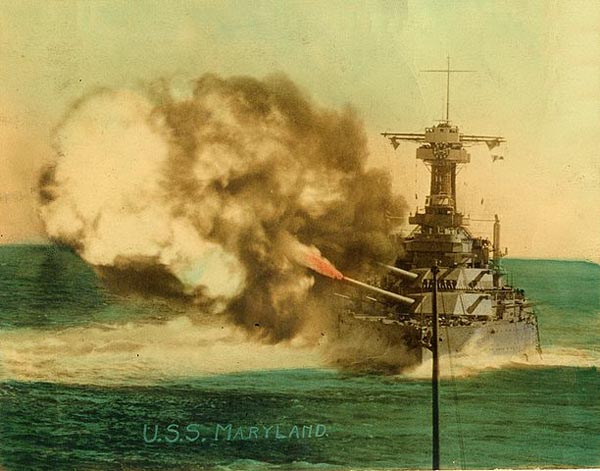
USS Maryland firing a broadside, 1920s
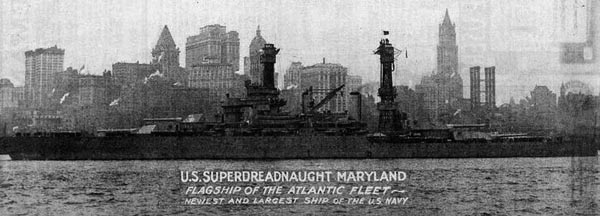
USS maryland in July 1922 in New York City, just commissioned
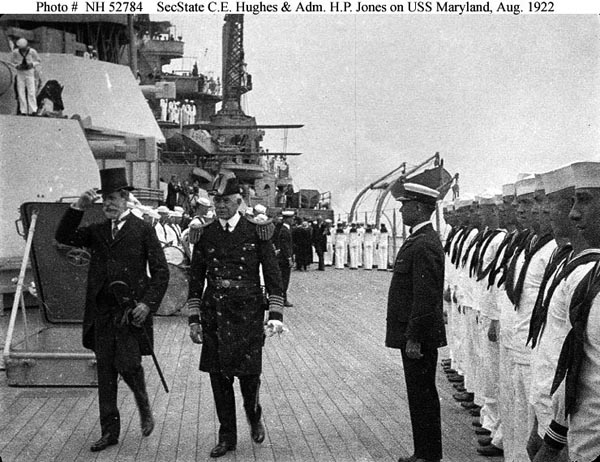
Admiral Hilary Jones presenting USS Maryland to senator C.E. Hugues in August 1922
Armament changes
Main:
The guns were partially rebuilt per standard navy practice (barrels replaced) and redesignated 16-inch/45 (40.6 cm) Mark 5 and Mark 8. Navweaps stats:
Light artillery
In 1922 already from four the AA armament was increased to eight guns. However, they were eliminated and replaced in 1928–1929 by eight 5-inch (127 mm)/25, all specific AA guns:
- 54 Ibs. (24 kg) shell
- Muzzle velocity 2,155 feet per second (657 m/s)
- Rate of fire 15-20 rpm
- Maximum range 14,500 yards (13,300 m) at 45°
- Ceiling 27,400 feet (8,400 m) at 85°
In 1937–1938 were added two quadruple-mount 1.1-inch/75-caliber guns, the infamous “Chicago Piano” for shorter range. Possiby also they carried Browning M2HB heavy machine guns in pairs but it is not known.
Protection changes
Like for the Tennessees, the Colorado class after WWI was schedued to have its protection revamped entirely, notaby due to the latest developments in ballistics and aviation. In the early 1930s, there was a redesign of the underwater protection scheme: Now it featured five compartments separated by armored bulkheads, each 0.75 inches (19 mm). The principle was to have an outer empty compartment, three filled, and another empty, now inner compartment. The eight boilers were placed in separate spaces port and starboard, on either side of the turboelectric powerplant. This ensure the ship could still sail with an entire boilers side underwater. Instead of a single large funnel, the silhouette still comprised two smaller funnels. Eventually, the turret armor was ioincreased as previously planned with 5 inches on the roofs, 8 inches on the sides, back, 18 inches for the turret faces.
Prewar modifications
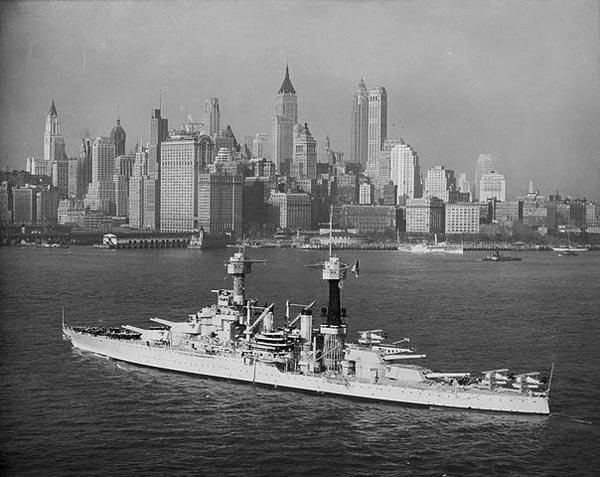
USS Colorado in 1932
The Navy studied the first war lessons from 1939 from the Royal Navy. The King Board (after USN C-in-C admiral King) in 1940–1941 proposed the secondary armament was boosted to deal with AA attacks, and the removal of all 5 in guns, to be replaced by the new the dual-purpose 5 in/38; This comprised to cut away the superstructure to have clean arcs of fire. In all, sixteen 5 in/38 in twin mounts was asked for (and implemented during 1942 reconstructions) plus sixteen Bofors 40 mm (all quad), plus eight single Oerlikon 20 mm. This added weight remains an interrogation however, plus dry dock immobilieation in uncertain times. As an interim measure, two more quad 1.1-inch were proposed, but this was marred by a slow production, and 3 in (76 mm)/50 were added instead of all battleships (except for Arizona and Nevada). It was all done by June 1941, and swapped by the quad 1.1-inch guns when available in November 1941 with priority given to the Atlantic fleet.
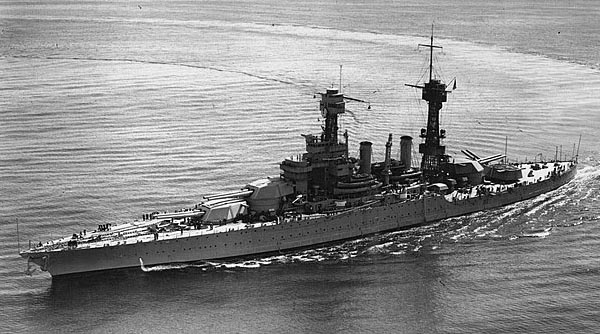
USS Colorado off San Diego, 1924
As planned, these modifications brought additional weight so torpedo bulges were added also to compensate. Total cost of these modification, now justified by war in Europe, was $750,000 and 2-3 month of drydock inactivity.
The King Board also suggested deck armor increase but this was dismissed by the Chief of Naval Operations. Puget Sound Naval Shipyard will saw all “big five” battleships enter its drydock for this: Maryland initiated the move before Pearl Harbor (17 February-20 May 1941), West Virginia (10 May-8 August 1914), Colorado (28 July-28 October 1941). The program went on also after Pearl harbor, USS Tennessee (19 January-21 April 1942), California (16 March-16 June 1942). Eventually only two would receive bulges as planned, Maryland (on 1 August 1941) and Colorado (on 26 February 1942). Pearl Harbor interrupted refit for USS West Virginia and the two Tennessees, Colorado being spared, in Puget Sound at the time, Maryland also being spared in Pearl by the attack. West Virginia was damaged to the point she was to be comprehensively rebuilt for not wasting her drydock time.

USS West Virginia, Pearl Harbor December 1941

USS Colorado, mid-1944, measure 32 design 2D
WW2 Reconstuctions & modifications
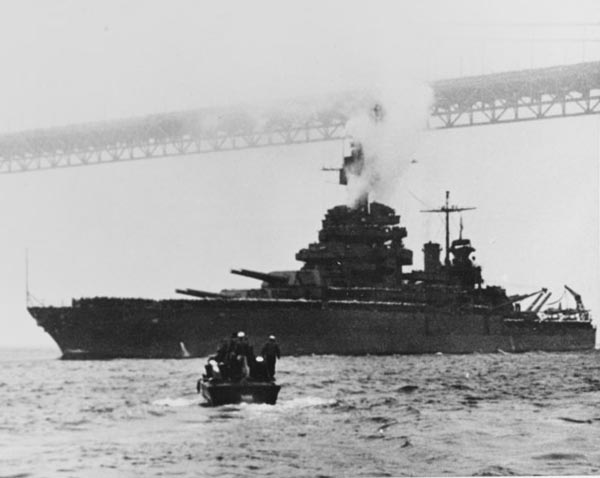
After the Pearl Habor attack reconstruction started for all ships refloated or slightly damaged. By late 1942, the eight single 5 in/38s were kept but 4×4 Bofors 40 mm guns, 32 Oerlikon 20 mm cannons were added. The first procured a first short range bubble of lead at 140-160 rpm at 22,299 feet (6,797 m) or 250/320 rpm at 10,000 feet. In 1942 also, Mark 15 main secondary guns were replaced on USS West Virginia y the planned sixteen 5-inch (127 mm)/38 Mark 12 in twin turrets and the superstructure rebuilt as planned. For Maryland and Colorado, they kept their ten Mark 15s but gained eight 5 in/38 cal Mark 12s in single mounts, but with protective shields. Twin turrets were installed later. Mark 12 5-in (127 mm) fired a 55.18-pound (25.03 kg) shell at 17,392 yards or 37,200 feet (11,300 m) at 45° with a high rate of fire at any angle and used proximity-fused shells from 1943.
A second round for AA defense in 1944-1945 saw both the dismissal of 20 mm and manually-controlled guns and more quad 40 mm Bofors were added instead: Maryland had forty quad 40 mm, eighteen 20 mm; Colorado forty quad but all her 20 mm guns; West Virginia forty quad also but fifty 20 mm guns, having by far the most impressive AA cover of admiral Oldenburg’s battle fleet. All these quad mounts required a crew of 5, so this added to the initial crew already in the ship, with some consequences in living conditions. Al because of the threat posed by Kamikazes.
The Pacific Fleet battleships could not be spared for extra modifications, maintained in a constant readiness state, to sail within 48 hours. Japanese invasion was expected for Hawaii or the West Coast in early 1942. Colorado however received a radar, splinter protection, fourteen Oerlikon 20 mm, four quad 1.1-in guns early on. Maryland received the same but later (but sixteen 20 mm guns, no 1.1-in guns). Tower masts were new on Colorado and Maryland, aft cage masts eliminated at the start of 1942 but time lacked to install the new tower masts, placed into storage until early 1944. it’s only when the situation stabilized enough in the pacific, and the admiralty realized the importance of aircraft carriers, that the “big five” were spared some extra time for these modification.
Colorado and Maryland had to wait for their major refit in 1944, with many modifications in between with each maintenance period. it’s only in 1944 that they lost their remaining aft cage masts and gain new radars in the process. More extensive refits proposed by Admiral Ernest J. King, (more twin 5 in/38 turrets, more advanced fire control systems, second protective deck plating) were contested by the Bureau of Ships over displacement considerations and proposed a reduced upgrade similar to the New Mexico class. When USS Maryland was badly hit and damaged by a kamikaze attack, she was both repaired and modernized, limited to the addition of the planned twin 5 in/38, conning tower removed and lighter STS bridge structure added.

⚙ USS West Virginia Specifications 1944 |
|
| Displacement | 33,000 tons standard, 34,000 FL |
| Dimensions | Same but 114 ft (35 m) beam |
| Armament | 8 × 16 in/45 (406 mm) Mk6, 16 × 5 in/38 (127 mm), 40× Bofors 40 mm, 43× Oerlikon 20 mm AA |
| Armor | See notes |
| Crew | 68+1400 |
The fate of USS Washington

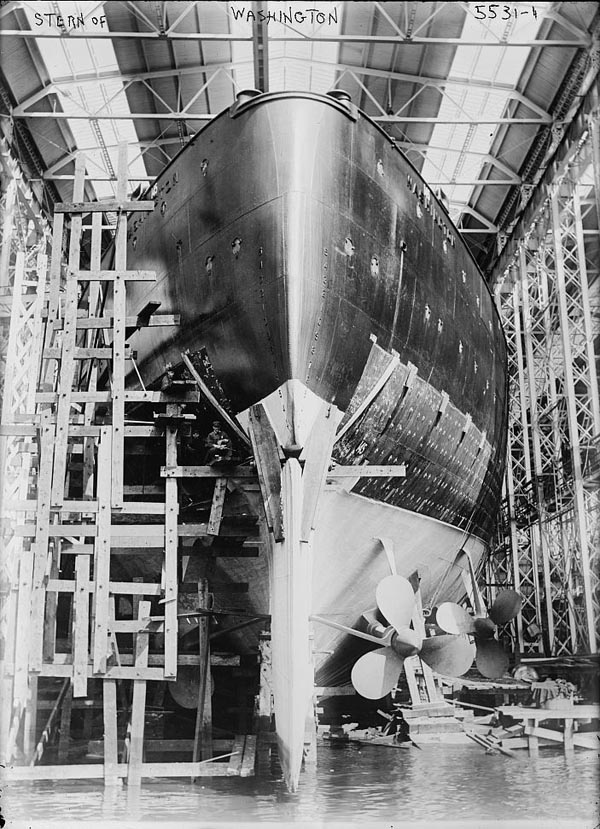
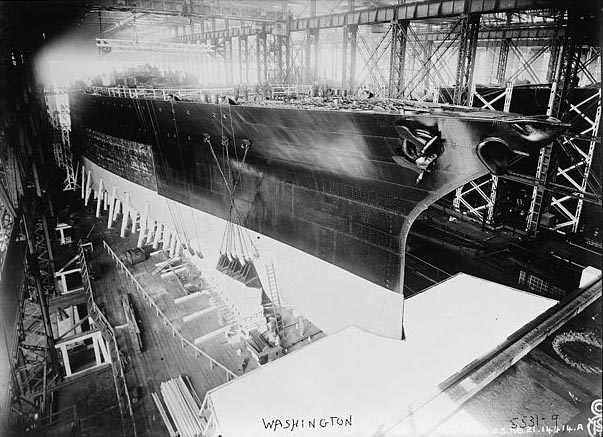
USS Washington in construction
Initially the Colorado class had four, and not three battleships planned. In 1916, design work was complete and USS Washington was provisioned four bronze propellers, four General Electric turbo-electric drives and eight oil-fired Babcock & Wilcox boilers. Her construction went on just after USS Colorado was laid down on 24 April 1917 so she had to wait until 30 June 1919. Eventually she was launched on 1st September 1921. However, the next year saw the cancellation of the South Dakota class and 8 February 1922, two days after the signing of the Washington Naval Treaty, all construction work stopped on USS Washington. At that stage she was 75.9% complete, with her underwater armored protection ready, and basic superstructures already built, her exhaut tubes in place. Now there was no question of completing her, but could she be converted as the Lexington class ? This was brushed aside due to her unsufficient speed, but the decision took years to come. She was mothballed until November 1924, and towed to be used as a gunnery target. At least the Navy would have seen how her newly design protection would stand the test of facts.
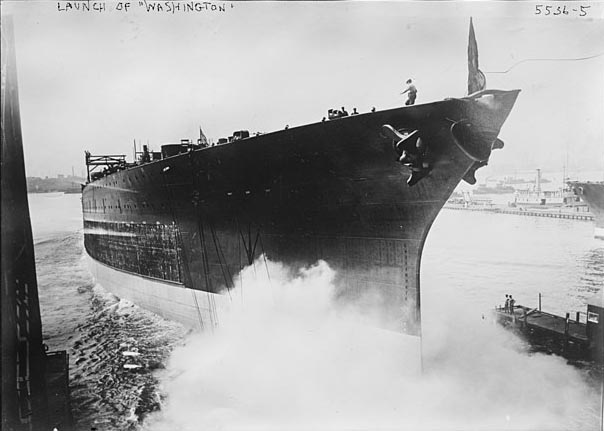
On the first day of testing, she received two 400-pound (180 kg) simultaneous torpedo hits, and survived. Later she was air-attacked and received three 1-metric-ton near-miss bombs hits. These causied minor damage but she accused a 3° list. Later she was tested by being detonated by 400 pounds of TNT on board, and survived again. Two days later, the gunnery tests rsumed and she received 14 hits from a 14-inch (356 mm) guns fired from 4,000 feet away. All but one failed to penetrate her main belt. Eventually, she was finished off by USS Texas and New York, hit 14 more times. The test was precious. It proved the existing deck armor was inadequate, and triple bottoms were now necessary, so to define a triple ASW layer of protection. She sank following the last test on 25 November 1924. Her name was given to the sister-ship of USS North Carolina, the first USN fast-battleship of the post-washington era, which design was in part based on this tests.
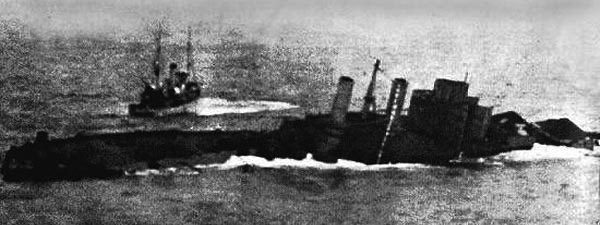
Resources
Books
J. Gardiner, Conway’s all the world’s fighting ships 1906-1921 and 1921-47
Breyer, Siegfried (1973). Battleships and Battle Cruisers 1905–1970. Doubleday and Company.
Ferguson, John C. (2007). Historic Battleship Texas: The Last Dreadnought. Military History of Texas #4.
Friedman, Norman (1985). U.S. Battleships: An Illustrated Design History. Naval Institute Press.
Newhart, Max (1995). American Battleships: A Pictorial History of BB-1 to BB-71. Pictorial Histories Publishing Co.
DiGiulian, Tony (7 February 2008) Navweaps.org
Sites
history.navy.mil Colorado
history.navy.mil Maryland
history.navy.mil West Virginia
More on history.navy.mil
navweaps – 16-in Mark 1
navweaps – 16-in Mark 5
navweaps – 5-in/51 Mark 7
navweaps – 3-in/25 Mark 10
On navypedia
On hyperwar.org, Naval Historical Center
On historyofwar.org
Open source photos – Wikimedia CC
Navsource.org
On the pac war online
Battleships camouflage measures
Videos
https://www.youtube.com/embed/T4rEjZdyNFs Battleship new Jersey channel: The Colorado class
https://www.youtube.com/embed/Wo-ke-871ms West Virginia by Drachinfels
Colorado by navyreviewer
Model Kit corner

Measure 32 – West Virginia scheme 1944

_port_side_camo-measure31.jpg)
Measure 31 – Maryland April 1944

Old Author’s rendition – USS Maryland 1943

Old Author’s rendition – USS West Virginia 1944

Colorado class on scalemates
On steelnavy.org
Onboard aviation
See also: http://www.steelnavy.net/3DMPCageMasts700.html
http://www.steelnavy.net/3DMPColoradoTops.html
http://www.usndazzle.com/design.php?class=1&category=2&design_num=3D&designed_for_type=BB&designed_for_num=45
http://www.usndazzle.com/ship.php?id=118
http://www.usndazzle.com/ship.php?id=119
In 3D

USS West Virginia in VR
Unfortunately, the model was removed.
See the HD world of warships rendition of West Virginia
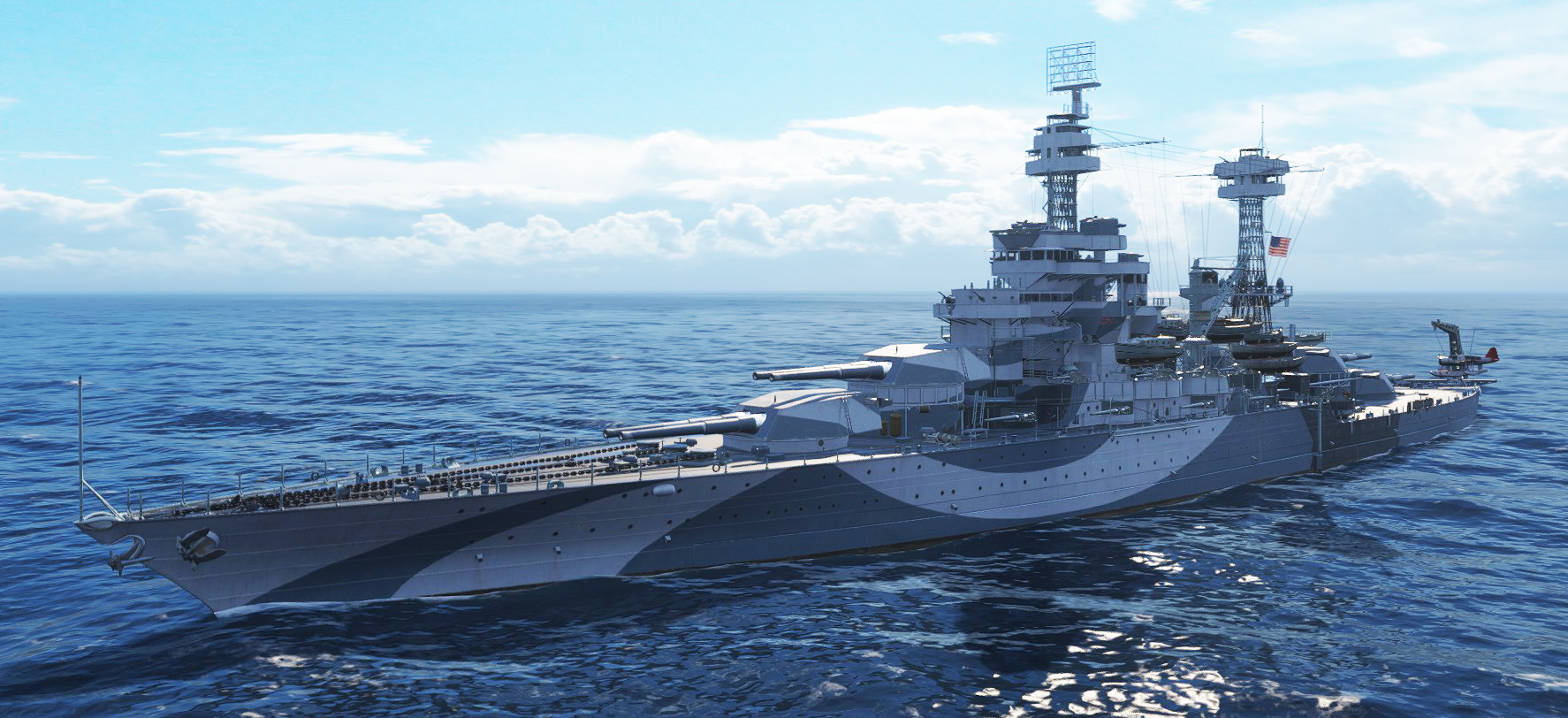
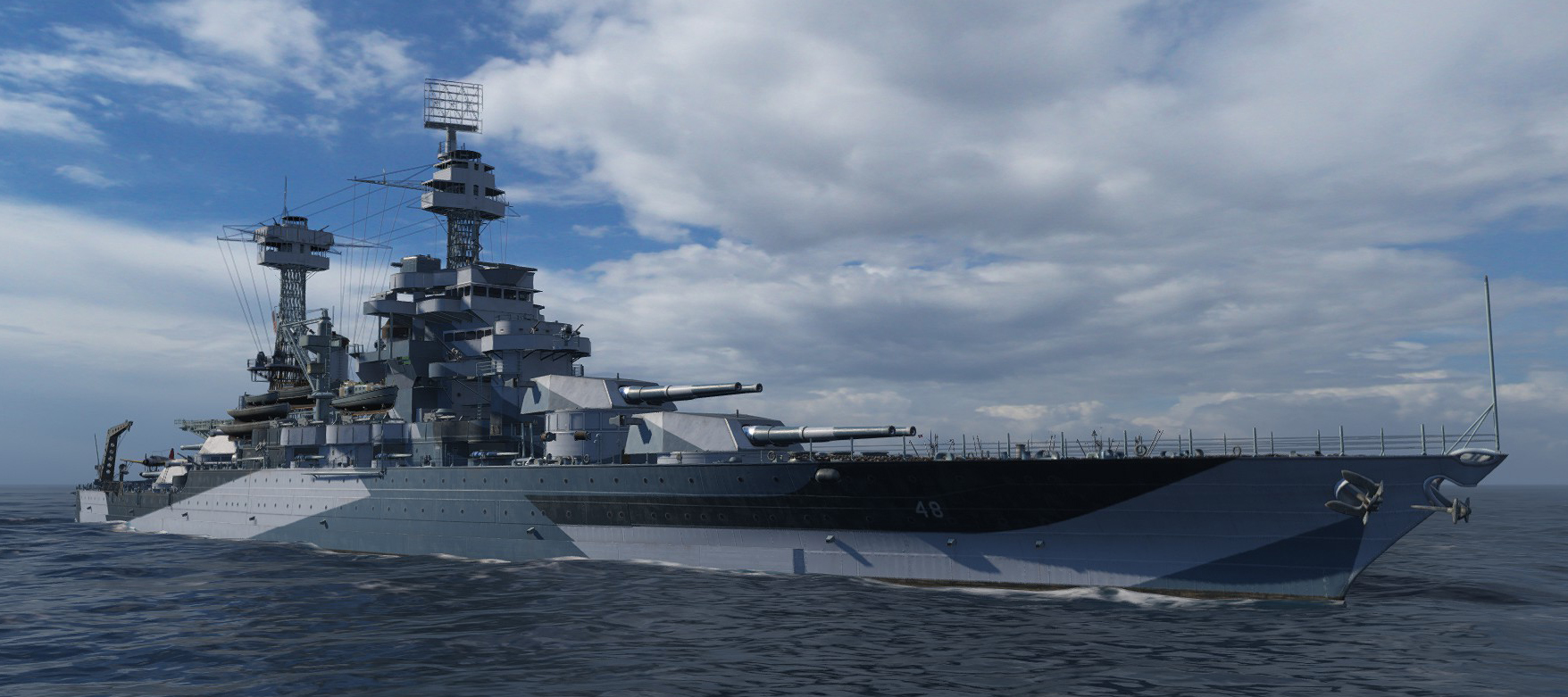
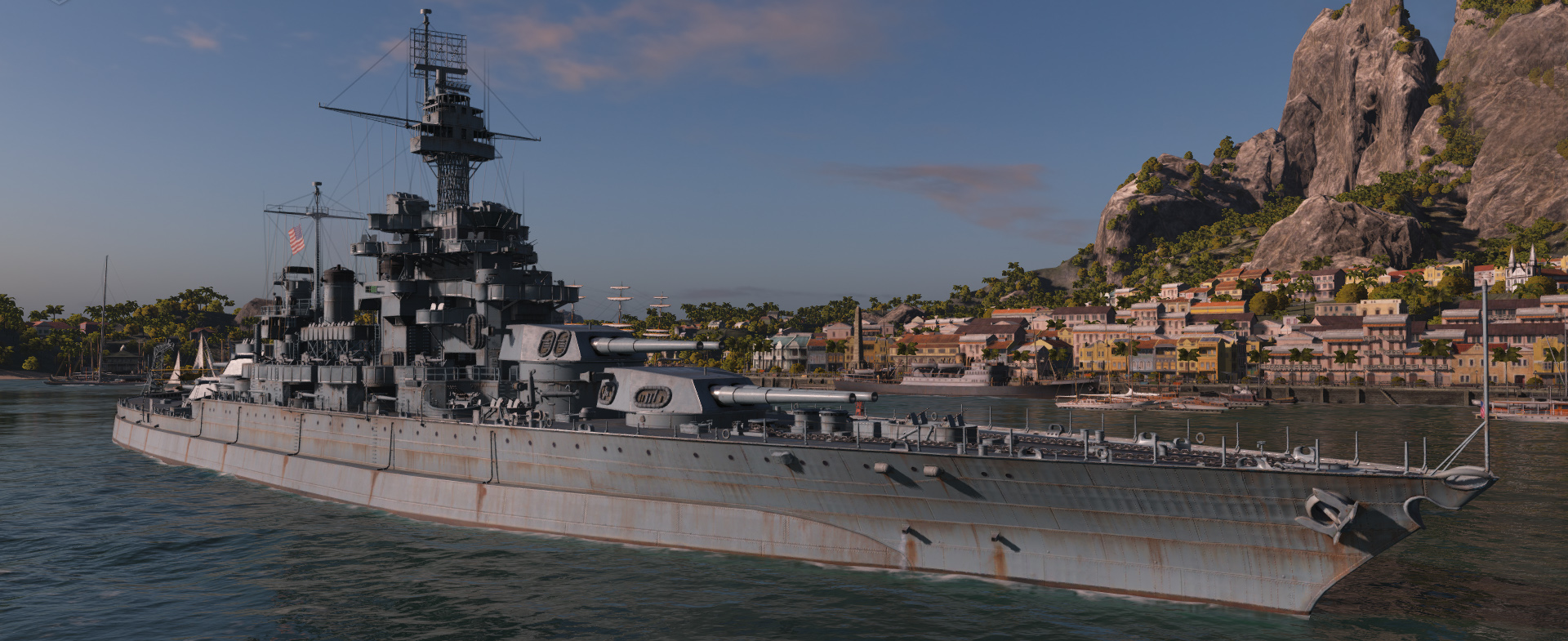
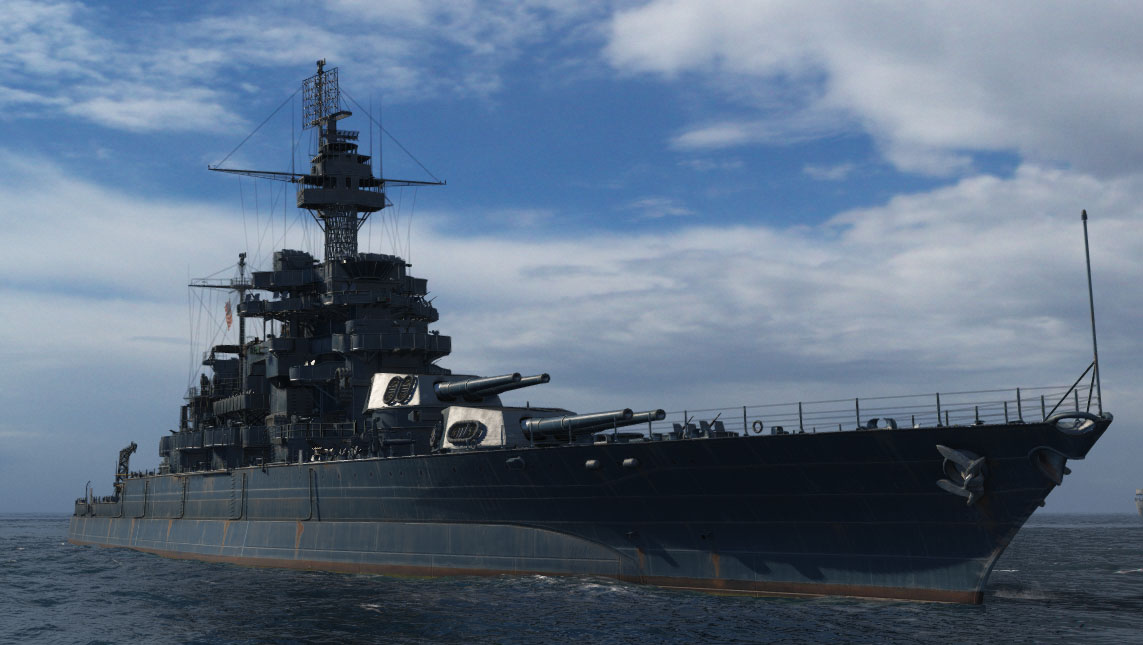

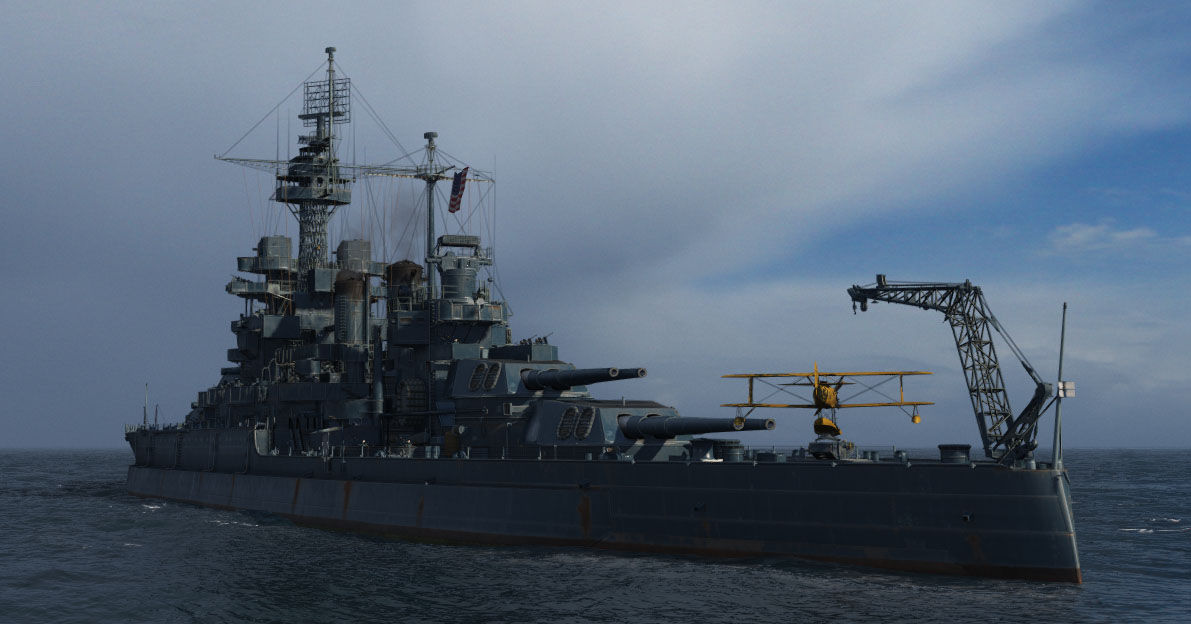
The Colorado class in service
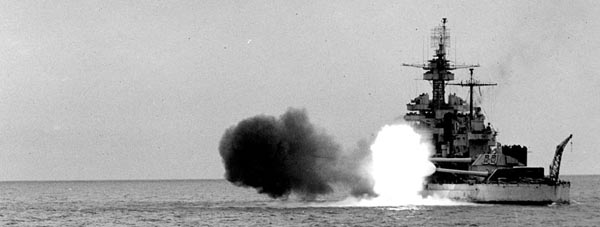
USS Colorado
Inter-war service
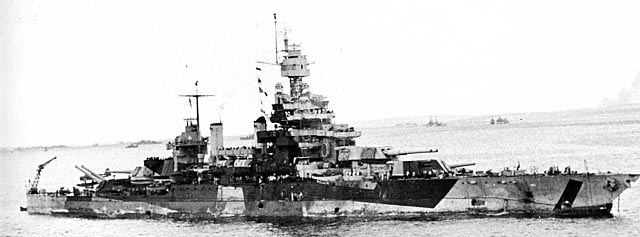
USS Colorado (BB-45) was laid down on 29 May 1919 at the New York Shipbuilding Corp. Camden (New Jersey), named for the 38th state. Launched on 22 March 1921 she was commissioned on 30 August 1923 and started her initial sea trials under her first commanding officer, Captain Reginald R. Belknap. On 29 December 1923, she departed New York for her shakedown cruiser, and arrived in Portsmouth, UK, visited Cherbourg, Villefranche-sur-Mer in France, passed the suez canal stopped in Naples (Italy) via Gibraltar. She was back in New York on 15 February 1924 for her post-cruise fixes and maintenance. After more tests she dearted for a training session on 11 July off the West Coast, passing the Panama canal and reaching San Francisco on 15 September to join the Battle Fleet.
Her interwar years saw her participating in many annual fleet problems between the Pacific and Caribbean Sea. She also took part in ceremonies and naval reviews. He other cruiser in 1925, saw her visiting Samoa, Australia, and New Zealand but she ran aground on the Diamond Shoals, off Cape Hatteras in North Carolina (1 May 1927), refloated and repaired.

USS Colorado profile (BB-45) in the late 1930s
Her first major overhaul took place in 1928–1929: She received notably eight 5-inch (130 mm)/25 AA guns. In 1933 she was sent to assist a relief party at Long Beach (California) after an earthquake. In 1937 Colorado became a provisional training ship for NROTC students (University of Washington & Berkeley), embarking them in Puget Sound on the 15 and 19 June in San Francisco Bay and sailed to Hilo, Hawaii, then Lahaina Roads to demonstrate her 5″/51 guns. She also went to search for Amelia Earhart. Escorted later by the Coast Guard cutter Itasca in July she launched her seaplanes off the Phoenix Islands and later returned with NROTC students. Nothing much happened in 1938-1940 but the usual routine.
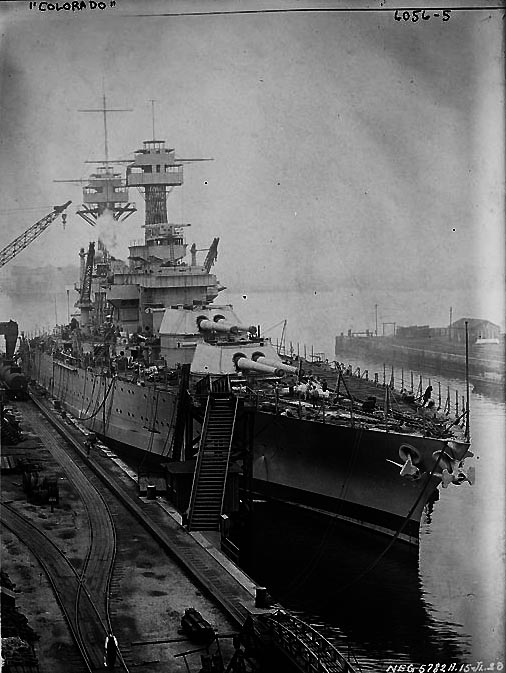
USS Colorado after commissioning
WW2 for USS Colorado
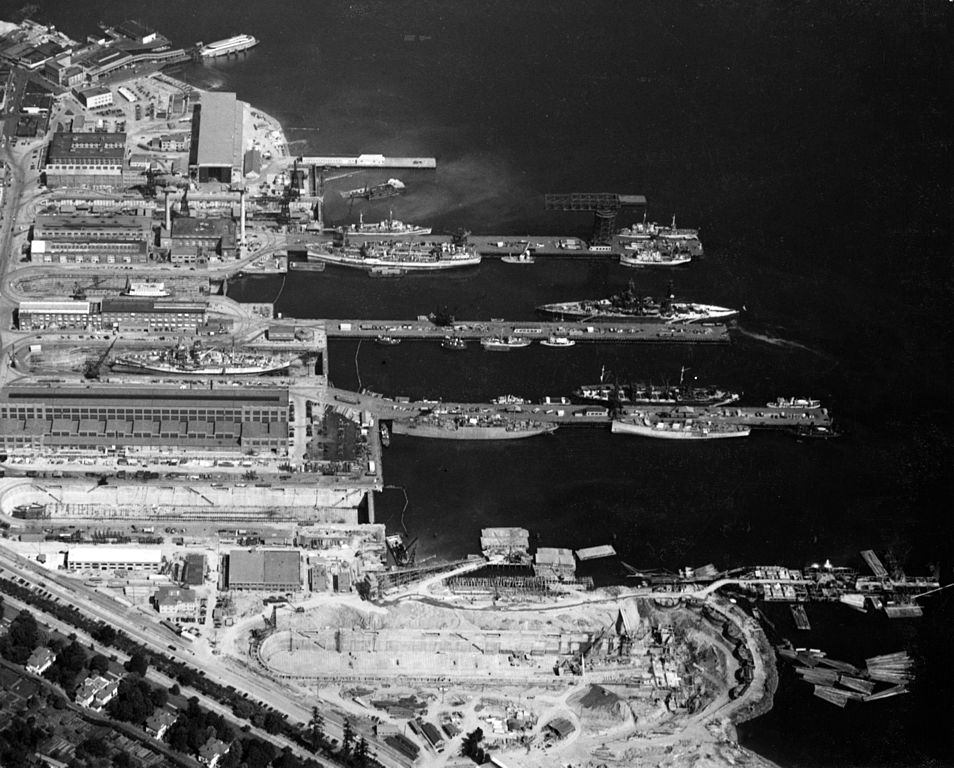
USS Colorado in Puget Sound, July 1941
On January 1941, USS Colorado was based in Pearl Harbor, making intensive training exercises because tension growing in the Pacific, taking part in large, realistic war games up to 25 June, and then headed to the West Coast for her major overhaul in Puget Sound. So she was not present on 7 Dec. when the attack started. Her refit which completed on 31 March 1942, and she received twelve 5 in/38 caliber guns. She started afterwards an extensive training session along the West Coast and on 31 May she sailed with her sister-ship USS Maryland off the Golden Gate Bridge, ostensibly to protect San Francisco from an expected large Japanese attack. Back to Pearl Harbor final preparations weremade for her pacific service and she was sent to the Fiji Islands and New Hebrides in November 1942. Until 17 September 1943 she stayed there ready to depart and interdict Japanese moves in this part of the Pacific. At last it was time for the start of her participation in the island-hopping campaign and she was back in Pearl Harbor by October 1943 to carry a heavy load of shells, providing fire support during the invasion of Tarawa and was back home on 7 December 1943.

USS Colorado firing in preparation for the Tarawa invasion, Nov.1943
After this second wartime overhaul she sailed to Lahaina Roads in the Hawaiian Islands on 21 January 1944 and sailed the day after to the Marshall Islands, providing the pre-invasion fire support during the Kwajalein-Eniwetok campaign, until 23 February. She sailed to Puget Sound Navy Yard for her third overhaul and was back to the Mariana Islands from San Francisco, departed on 5 May, via Pearl Harbor and Kwajalein. Dhe took part in the shelling of Saipan, Guam, and Tinian in June-July. Off Tinian she was hit by a Japanese 6-in shore battery on 24 July: 43 men were killed, 198 wounded after 22 hits. She went on with her fire support during the invasion and head back to the West Coast for repairs. She was back in time for the invasion of Leyte Gulf. two weeks into this, she was attacked by waves of Kamikazes and struck by two kamikaze bombers: 19 crewmembers diede as a result, while 72 were injured.but damage was moderate and she shot down mant assailants. She bombarded Mindoro on 12-17 December 1944 and sailed to Manus Island for repairs.
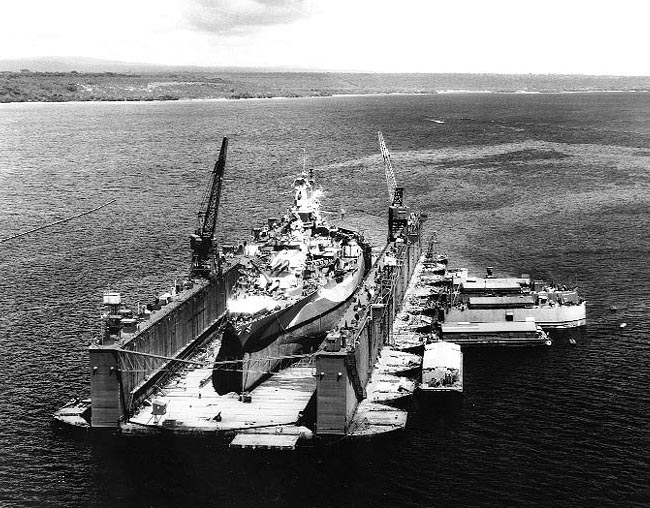
USS Colorado in emergency repairs in ABSD floating drydock
On 31 dec. 1945 she sailed to participate to the preparation shelling in the Lingayen Gulf. She took accidental gunfire on 8 January, damaging her superstructure; She deplored 69 casualties, including 18 killed. After repairs at Ulithi she joined TF 54 for the invasion of Okinawa and was stationed at Kerama Retto. She provided gunnery support until 22 May, and anti-aircraft cover during untrelentles and massive kamikaze attacks. On 6 August 1945 she sailed to Japan to prepare for Operation Olympic. On 27 August, she covered the occupation of Atsugi Airfield. War was over for USS Colorado, and she was awarded seven battle stars for this service.
She departed Tokyo Bay on 20 September 1945 for San Francisco, arriving n 15 October, then headed for Seattle, participating in Navy Day on 27 October and sailed back for Operation Magic Carpet, making three runs to Pearl Harbor, carryng 6357 soldiers in all. Sje was back to the Bremerton Navy Yard for deactivation, reserve commission until 7 January 1947. Mothballed for long reserve, she was not exhumed for Korean service and was stricken and sold for scrap on 23 July 1959.

USS Maryland
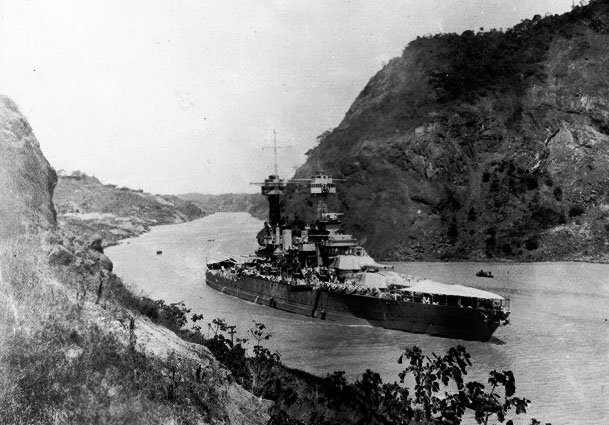
Interwar
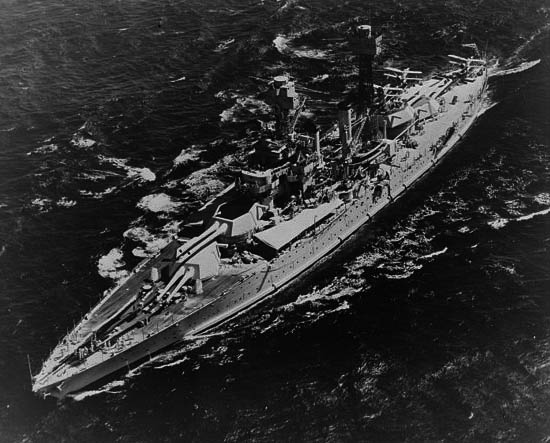
USS Maryland’s keel was laid down on 24 April 1917 at Newport News Shipbuilding Company in Virginia. She was launched on 20 March 1920 and commissioned on 21 July 1921, starting right away after some training her east coast shakedown cruise. After it she became flagship of Admiral Hilary P. Jones and appeared soon in many special occasions like for the 1922 United States Naval Academy graduation and at Boston, Massachusetts, the anniversary of the battle of Bunker Hill, Fourth of July celebrations… In August she departed with Secretary of State Charles Evans Hughes to Rio de Janeiro, at the occasion of Brazil’s Centennial Exposition. Crossing the Panama Canal, USS Maryland ventured in June 1922 the west coast fleet for exercizes, and stayed a flagship until 1923 when it was given to USS Pennsylvania. In 1925 she cruised to Australia and New Zealand. In between routine exercizes between the east and west coast went on, with yearly maintenance periods. In 1928, she carried newly elected president Herbert Hoover in a Pacific tour of Latin America. BB-46 had her major overhauled in 1928–1929, receiving like her sister eight 5-inch/25 cal guns. During the 1930s, she stayed in maximum fleet readiness in frequent training operations and numerous long patrols an cruises. After all she was the latest and most recent USN Battleship, its very spearhead with both her sister-ships.
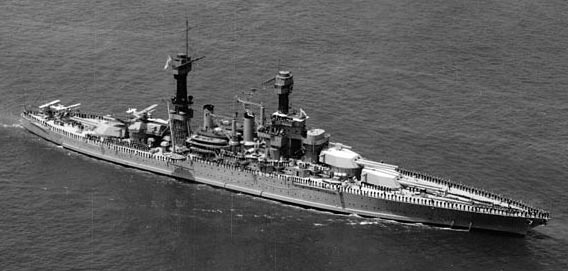
USS Maryland during a naval review in 1927
USS Maryland’s miracle at Pearl Harbor
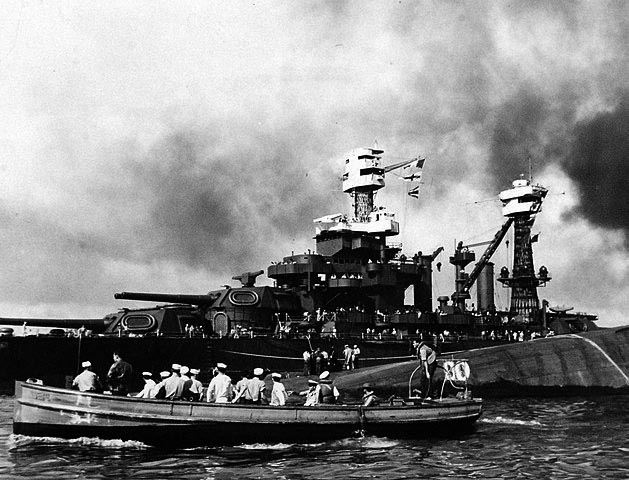
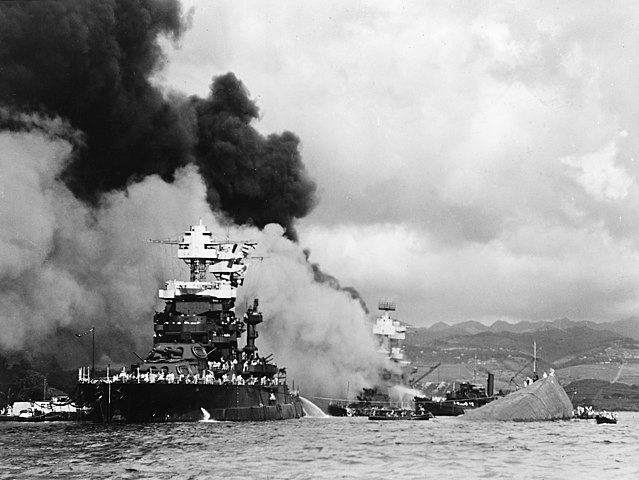
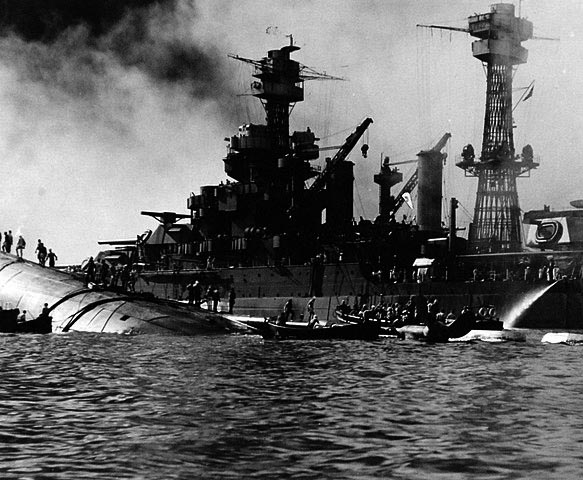
In 1940, USS Maryland and her sisters of the “big five” plus the rest of the battle force were all realocated tp Pearl Harbor, and she was in the Battleship Row along Ford Island on 7 December 1941. She was berthed along USS Oklahoma which in fact shielded her from the sea, sandwich in between her her Ford island moorings. USS Colorado was already absent for a refit, however West Virginia was fully exposed, which explained what happened afterwards. Connected by lines and a gangway her crew could quickly -if needed- access to the stores nearby in case. On her fore position was anchored USS California, and Tennessee and West Virginia were astern her and further aft USS Nevada and Arizona. So she was well “protected” all around. These seven battleships recently returned from intensive large scale and complex maneuvers. Most of her crew was preparing for shore leave this sunny and peaceful sunday and at 09:00, they were just settled to eat breakfast when the attack erupted. Soon, the bugler blew general quarters and Seaman Leslie Short was the first to act, manning his machine gun and shooting down one of two torpedo bombers targeting USS Oklahoma. The latter took torpedoes that spared USS Maryland, while all her crew managed to bring her antiaircraft batteries into action very fast, playing an important role in the deperate defense to come. Oklahoma was fatally wounded, capsized quickly but fortunately her links with Marylands were cut. However any of her surviving crewmen were rescued by USS Maryland and wen on assisting her for AA defense, carrying ammunitions notably.
Eventually luck run out for USS Maryland as she was also in the IJN’s list. She was targeted by several dive-bombers and soon was struck by two armor-piercing bombs and several near-misses. The two specially-crafted bombs from modified AP shells tore down through her weak deck protection and detonated low in her hull. The first fell near the forecastle realtively high, blewing an entry hole 12 ft (3.7 m) by 20 ft (6.1 m) while the second detonated at about 22 ft (6.7 m), just at water level, at Frame 10, causing massive flooding. Soon, BB-46 had a list and her draft forward increased by 5 ft (1.5 m). Nevertheless, there was nothing critical here and she went on firing while sending firefighting partieson other ships, and boats lowered to rescue survivors from Oklahoma. All hands on deck, between a fierce AA defense when the second wave passed, expecting the third, which never came, at great relief for all present. Nevertheless, USS Maryland had been relatively spared by this attack and lost two officers and two sailors, a very low casualty rate among the battleships present, hence the “miracle”. Nevertheless, the Japanese announced her sunk.
Repairs and early operations (1942)
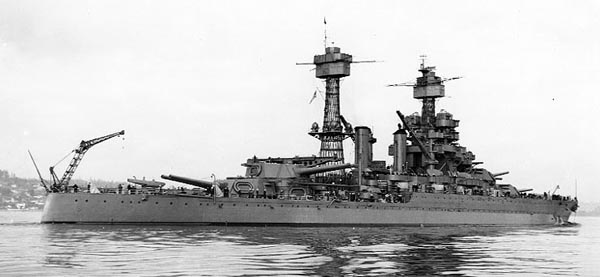
USS Maryland’s stern, 9 February 1942
On 30 December, BB-44 entered Puget Sound for repairs, behind USS Tennessee, also relatively spared in the attack. Two 5-inch/51 guns were removed and her remaining 5-inch/25 guns were replaced by additional ingle mount 5-inch/38 cal dual purpose guns,a long other quick modifications. She stayed in the drydock for two months, leaving on 26 February 1942, followed by a serie of shakedown cruises along the West Coast, down to the Christmas Islands. In June 1942 she was declared ready for action, being the second battleship damaged at Pearl Harbor reporting for duty. She started with an important support role at the Battle of Midway. She was not fast enough to follow the aircraft carriers and stayed as a backup fleet along the West Coast. Ready for a call in case Yamamoto would pursue the Americans. Afterwards she was sent to San Francisco for preparations. She was soon affected to Battleship Division 2, Battleship Division 3, and latter Battleship Division 4 until August 1942, with a maintenance time in between to Pearl Harbor for repairs. In November she departed with her sister ship USS Colorado for the Fiji Islands, patrolling against any Japanese incursion towards Australia, making frequent sweeps looking for Japanese forces in between.
1943 operations: Tarawa
In February 1943, USS Maryland and Colorado, still teaming as the division 4, moved to New Hebrides and off Efate and then Espiritu Santo, also to guard against a Japanese move there. She was also stationed off Aore Island Harbor and made a five weeks overhaut at Pearl Harbor, loading notably many Bofors quad 40mm mounts. Soon came her fuirst true wartime test: The Battle of Tarawa. Departing Pearl on 20 October 1943 she became flagship for Rear Admiral Harry W. Hill at the head of V Amphibious Force, Southern Attack Force, for the Gilbert Islands Invasion. Onboard was also Major General Julian C. Smith (2nd Marine Division), Colonel Evans Carlson (Carlson’s Raiders). After preparations at Efate Island, she joined the large task force for the preparatory shelling. Maryland’s guns opened fire at 05:00 on 20 November, destroying a shore battery south of Betio Island, then the shore bombardment and moved closer to locate gun emplacements and silent them. She also targeted control stations, pillboxes and installations visible. At 09:00 the Marines landed and soon wre hard fighting, communicating to USS Maryland Japanese machine gun nests they encountered, depite the danger of close proximity. The battleships’s scouting plane were also hard at work that day, fortunately with weak Japanese air defense, athough one plane was dhot down eventually. Marines progression went on, for three days on Betio Island. USS Maryland the moved to Apamama Island to cover other landings (light resistance there) and on 7 December 1943 she left Apamama for Pearl Harbor, and San Francisco for overhaul and crew’s rest.
1944 operations: Kwajalein, Saipan and Leyte
Next, BB-44 was present at the Battle of Kwajalein Atoll. She sailed from San Pedro (California) on 13 January 1944, met Task Force 53 at Lahaina Roadsand prepared for the Marshall Islands campaign. On 30 January she arrived to provide gunnery support during the attack on Roi Island, for TF 35. On 31 January, she started ap preparatory bombardment off Kwajalein Atoll, targeting stationary guns and pillboxes at will. In fact her gunfire was so intense that she split the liners of her gun barrels in Turret No. 1, now silenced. On 1 February, she went on supporting the Marines, now as flagship for Admiral Connally, also resupplying and refueling smaller ships present and departing on 15 February 1944 for Bremerton NyD for another overhaul. There she had her worn-out barrels replaced. In May 1944, she joined Task Force 52 in preparation for the assault on Saipan. Inder command of Vice Admiral Richmond K. Turner, TF 52 was given three days of shelling.
Firing commenced at 05:45 on 14 June and she destroyed two coastal guns, devastated Garapan’s installations, then Tanapag. The invasion started on 15 June, and she provided closer fire support. On 18 June, however the IJN aviation arrived and started to attack the ships present. She shot down one, but on 22 June a G4M3 “Betty” medium bomber dropped a torpedo and hit Maryland’s starboard bow. There were 2 casualties but she listed slightly (compensated by counter-filling) and had to sail to Eniwetok, to be patched, and then to Pearl Harbor for repairs escorted by two destroyers.
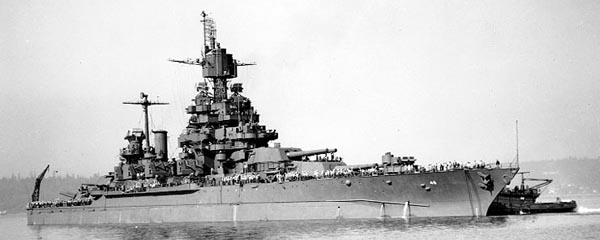
Shipyard workers manage to have her repaired in record time and the much-needed Maryland was out in 34 days, sailing again on 13 August. She met a large TF in the Solomon Islands in Purvis Bay, off Florida Island and stayed there until heading for the Palau Islands on 6 September 1944, to be mustered in the newly constituted Western Fire Support Group (Task Group 32.5; TG 32.5) Rear Admiral Jesse B. Oldendorf, with her sister ships from the battered “battleships row”. On 12 September she covered minesweeping operations, underwater demolition teams before the assault on Peleliu, followed by shore bombardment on 15 September and four days of fire support. USS Maryland the retired to the Admiralty Islands, and Seeadler Harbor, Manus. She was there assigned to the 7th Fleet (Admiral Kinkaid), sailing on 12 October while BB-44 joined Task Group 77.2 for support gunfire for the invasion of Leyte alongside four other battleships. The operation commenced on 18 October and USS Maryland was placed between Red and White Beaches, started firing at 10:00 20 October. Air raids followed the next days, including kamikaze attacks. Later, in the South China Sea two Japanese forces were spotted on approach, heading notably for San Bernardino Strait, and northern Luzon.

USS Maryland’s bow 1944
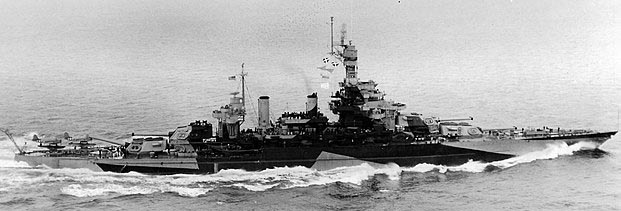
Post overhaul speed trials, April 1944
On 24 October, USS Maryland, her sister ship West Virginia, USS Mississippi, Tennessee, California, and Pennsylvania sailed to the southern end of Leyte Gulf, barring the Surigao Strait with an important escort. On 25 October the Battle of Surigao Strait saw the end of Fusō and Yamashiro. USS marymand pounded Yamashiro, sending the rest fleeing to the Mindanao Sea. Follwing her only battleship engagement of this war, USS Maryland patrolled the southern approaches of Surigao Strait until 29 October 1944, and steamed for the Admiralty Islands for replenishment and was back on 16 November, covering landing forces notably by her AA defense. On 29 November she repelled another air attack, when a kamikaze struck her between the Turrets No. 1 and 2. They penetrated the forecastle and armored decks, causing extensive damage and fires. 31 men were killed, 30 wounded whereas the medical department was badly damaged. She went on in her patrols and was back in Pearl Harbor on 18 December, repaired and refitted for two month.
Final Operations: Battle of Okinawa
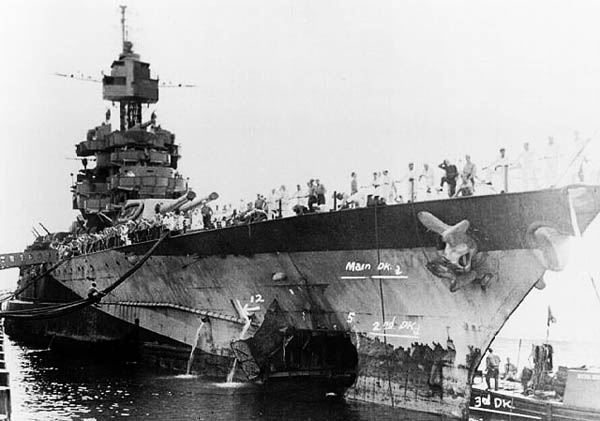
USS Maryland struck by an aerial torpedo
USS Maryland made a short refresher training, and was sailing for the Ulithi atoll on 4 March 1945, arriving on the 16 and reporting for duty to 5th Fleet, affected to Task Force 54 (Rear Admiral Morton Deyo) in preparation for the invasion of Okinawa. She was assigned targets on the southern coast of Okinawa, the diversionary landing. Several air raids followed, piched up and followed by Maryland’s radar picket destroyers. One of them, USS Luce was sank. On 3 April, she headed for the west coast to deal with newly spotted shore batteries and remained in close support force off Bolo Point, until 7 April. The she sailed with TF 54 to inteercep a last-ditch Japanese fleet, including the Yamato. However U.S. air attacks dealt with it, sinking six out of 10 ships in it. At dusk however, a kamikaze attack started and one, loaded with a 551 lb bomb targeted Maryland. It crashed on top of Turret No. 3, from starboard. The massive explosion wiped out all 20 mm guns nearby, also starting a massive fire from ignited 20mm ammunition. She deplored 10 killed, 37 injured, 6 missing that day.
USS Maryland remained for artillery support and repelled other air raids and departed on 14 April 1945 to escort retiring transports via the Mariana Islands, Guam and to Pearl Harbor. She went on to the Puget Sound Navy Yard on 7 May for an extensive overhaul, her last in fact. Her remaining 5 in guns were removed, plate over, sixteen 5 inch/38 cal guns in twin turrets were added and Turret No. 3 was repaired, crew quarters were improved. She was out in August 1945, making her training runs on V-Day. She later took part in Operation Magic Carpet, making five runs (8,000 servicemen), and headed to Seattle, Washington on 17 December 1945, then was sent to Puget Sound Naval Shipyard on 15 April 1946 to join the inactive reserve, preserved for years. on 16 July. She was decommissioned at Bremerton on 3 April 1947, Pacific Reserve Fleet and sold for scrap on 8 July 1959. She won seven battle stars for her service.
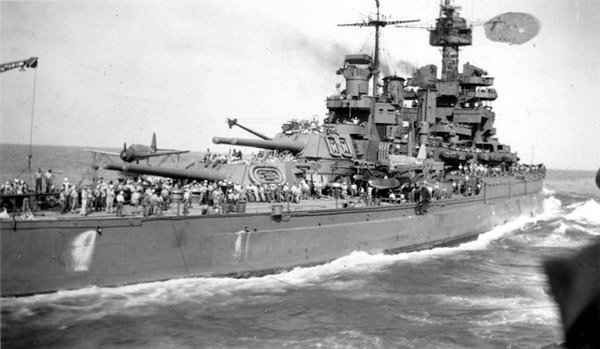
USS Maryland in 1945
USS West Virginia
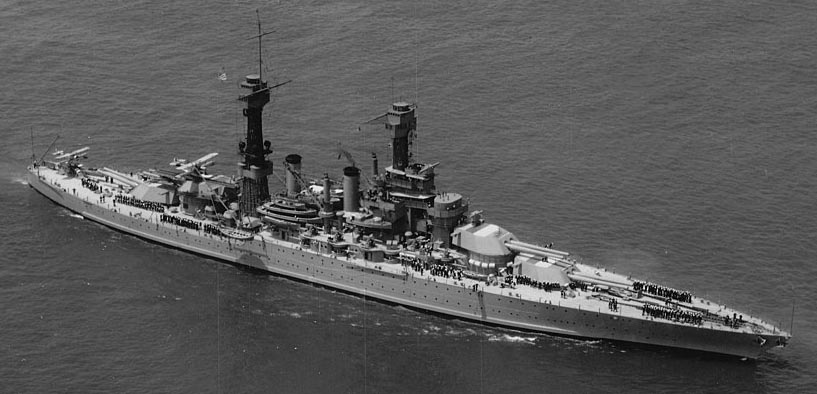
USS West Viginia, BB-46, during a naval review in 1927 (NARA)
USS West Virginia’s keel was laid down at Newport News Yard in Virginia on 12 April 1920, with the hull initial number BB-48 on 17 July. Launched on 17 November 1921, commissioned on 1 December 1923 she had for Captain Thomas J. Senn. After sea trials and shakedown cruise, plus fixes at Newport News she sailed to the New York Navy Yard for further alterations and headed to Hampton Roads, which allowed to spot her steering gear was problematic which was followed by quick repair. On 16 June 1924 when crossing Lynnhaven Channel, at 10:10 however, telegraphs for the engine room and steering compartment lost power. Voice tubes were used to communicate with the engine room and the captain used the port and starboard shafts to try to manoeuver, but the ship ran to the shore on initial inertia and ran aground. The later inquiry faulted incorrect navigational data also. On 30 October, USS West Virginia became flagship of the Battleship Divisions. The 1920s were spent in training and exercises routine with the fleet, overhauls, then Fleet Problems and west/east coast crusies.
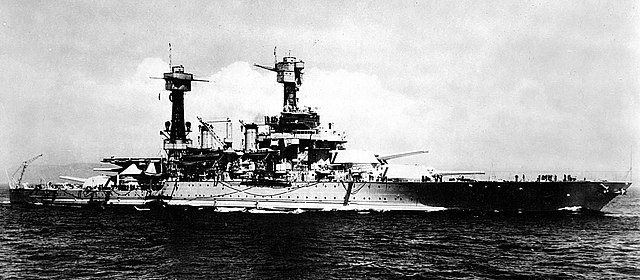
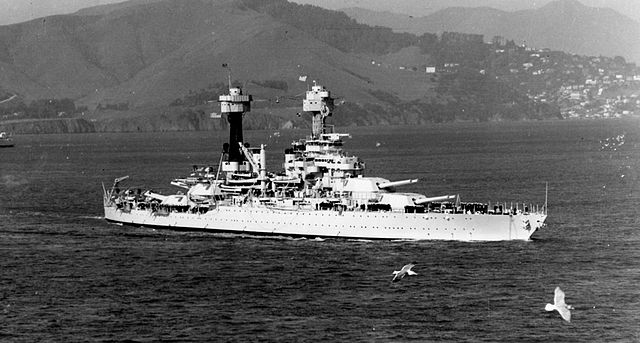
USS West Virginia in 1935
During these, BB-48 ventured as far as Alaska north. In 1925 Captain Arthur Japy Hepburn took command and the ship was praised for her gunners marksmanship, 1st prize for short range shooting. She also won the Battle Efficiency Ribbon (BER). She sailed in 1926 to Australia and New Zealand but her crew was awarded the BER again in 1927, 1932, and 1933. The ship underwent a minor modification and notably received aircraft catapults on her quarterdeck and N°3 turret, participating in Fleet Problem XIV in February 1933. Nothing much happened as the economical crisis twharted attempt to modernize her. In 1939, Admiral Ernest King was onboard, evaluating her anti-aircraft defenses. Her recommended adding blisters and adding 5 in/38 cal. DP guns as well as strengthening her decks. Modifications planned were to take place from 10 May to 8 August 1941 but were never carried out. In 1940, USS West Virginia participated in Fleet Problem XXI in April. She was moved rapidly to Pearl Harbor as tensions rose in the Pacific. 1941 was spent in extensive training while she received old 3 in guns for AA defense and eleven .50-cal. machine guns. In June 1941 an experimental gun shield was created by the crew for the 5 in guns, soon recommended.
Badly Damaged at Pearl
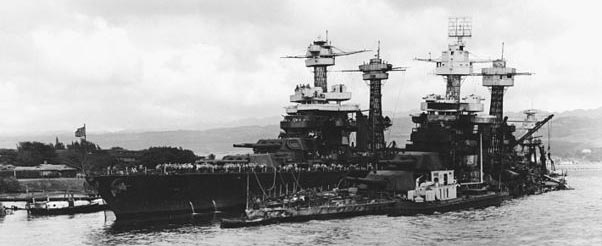
On the morning of 7 December 1941, was in Battleship Row in Pearl Harbor alongside Tennessee. She was hit by two Type 91 torpedoes on the port side, and two bombs. The first penetrated on the port side into the superstructure deck and blasting casemates below, also exploding the secondary ammunition stores, spreading into the galley deck. The second hit close to the rear superfiring turret roof but luckily failed to explode, but destroyed one gun cradle and the OS2U Kingfisher floatplane on the catapult atop, the second on the main deck took fire, spilling gasoline and only causing more damage. The first torpedo hit aft, disabling the rudder four the belt, three below and another at the waterline, damaging seven armor plates, opening two large holes (frames 43-52, 62-97) while another one passed even through the holes after the ship started to list, exploding inside the second armor deck. The ship only avoided capsizing through very efficient damage control team efforts (Lieutenant Claude V. Ricketts was later rewarded), the 1st fire control officer. Captain Mervyn S. Bennion was mortally wounded by shrapnel commanding the defense until he died and poshumously awarded the Medal of Honor. USS West Virginia, later affectionately nicknamed by sailors “wee-wee”, sank on even keel. Order to abandon ship was passed on but small teams stayed behind, firefighting and another searching for survivors to rescue. Fuel oil leaking from USS Arizona eventually caught fire, surrounding West Virginia completely added to her own leaking fuel oil. It’s only the next day that the last fires were extinguished. 106 men were killed, many more wounded, the ship almost a total constructive loss that day. One of the most badly beaten ship at Pearl. There are no records of her AA defense, but due to the confusion and smoke after the first hits, it was probably difficult to assess her role precisely.
Repairs and modernization
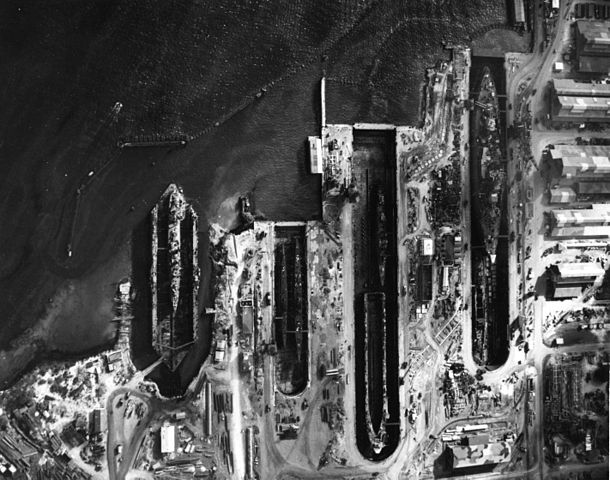
Workers at Pearl Harbor drydock made wonders fixing the hull, patching holes, pumping her dry, and she was fully refloated by 17 May 1942. This was one of the longest recovery of any ship in the “battleship row” and therefore after extensive repairs and reconstruction, her career was rather short. She was inspected in June in Dry Dock No. 1, Pearl Harbor and it was discovered she has been hit by no less than seven torpedoes. Her temporary repairs made her seaworthy enough to steam to Puget Sound, while 66 or 70 men trapped inside had been retreived and buried. Some of these unfortunately survived for several days in shrinking air bubbles, eating emergency rations, but in vain. Three even managed to survive for no less than sixteen days as it was later found until oxygen ran out. In Puget Sound Navy Yard (Bremerton) engineers wanted for her a thorough reconstruction, that could be worth the wartime decommission.
Modernization proposals soon settled on replacing the lattice masts to have a lighter but stronger structure to support a large radar equipment. West Virginia and California were both in the same state after Pearl, so the same design was applied to their long reconstruction. First off, they received the bulges planned for long, offseting the 1,400 long additional tons of deck armor she would receive. Their battery superstructure (former casemate deck) was rebuilt to manage a full set of sixteen dual-purpose 5-inch guns in twin turrets. However there were few drydocks available so West Virginia had to wait until Tennessee and California were rebuilt, being the last of the Pearl survivors to be completed, in September 1944.

Whe she emerged, her superstructure was brand new, without conning tower but a smaller tower and new bridge and staged superstructure around the now unique funnel, and new telemeters stages around this central island. This maximized the arc of fire for all extra quad Bofors and 20 mm positions around and of the course the 5-in turrets. In fact her new tower was removed from one of the Brooklyn-class cruisers, just rebuilt. The tower mast housed the bridge and main battery director. She was given a brand new air-search radar and recent fire-control radar, much more accurate that anything on the seas in 1943. The 5-in were controlled by four Mk 37 directors. The light AA battery culminated to ten quadruple 40 mm Bofors, forty-three 20 mm Oerlikons. In July 1944, this was mostly over so BB-48 started her pos-reconstruction trials, loaded ammunition on 2 July, departing for training her new crew off Port Townsend (Washington). Evaluations went on until 12 July and after fixed at Puget Sound she steamed to San Pedro near Los Angeles, making her shakedown cruise. She then proceeded to Hawaii on 14 September. On 23 September, she was assigned to Battleship Division 4 (BatDiv 4) with her sister ships, centered around the new Essex-class fleet carrier USS Hancock. They proceeded to Manus (Admiralty Islands), preparing and training for the upcoming campaign in the Philippines. On 6 October West Virginia became division flagship (Rear Admiral Theodore D. Ruddock).
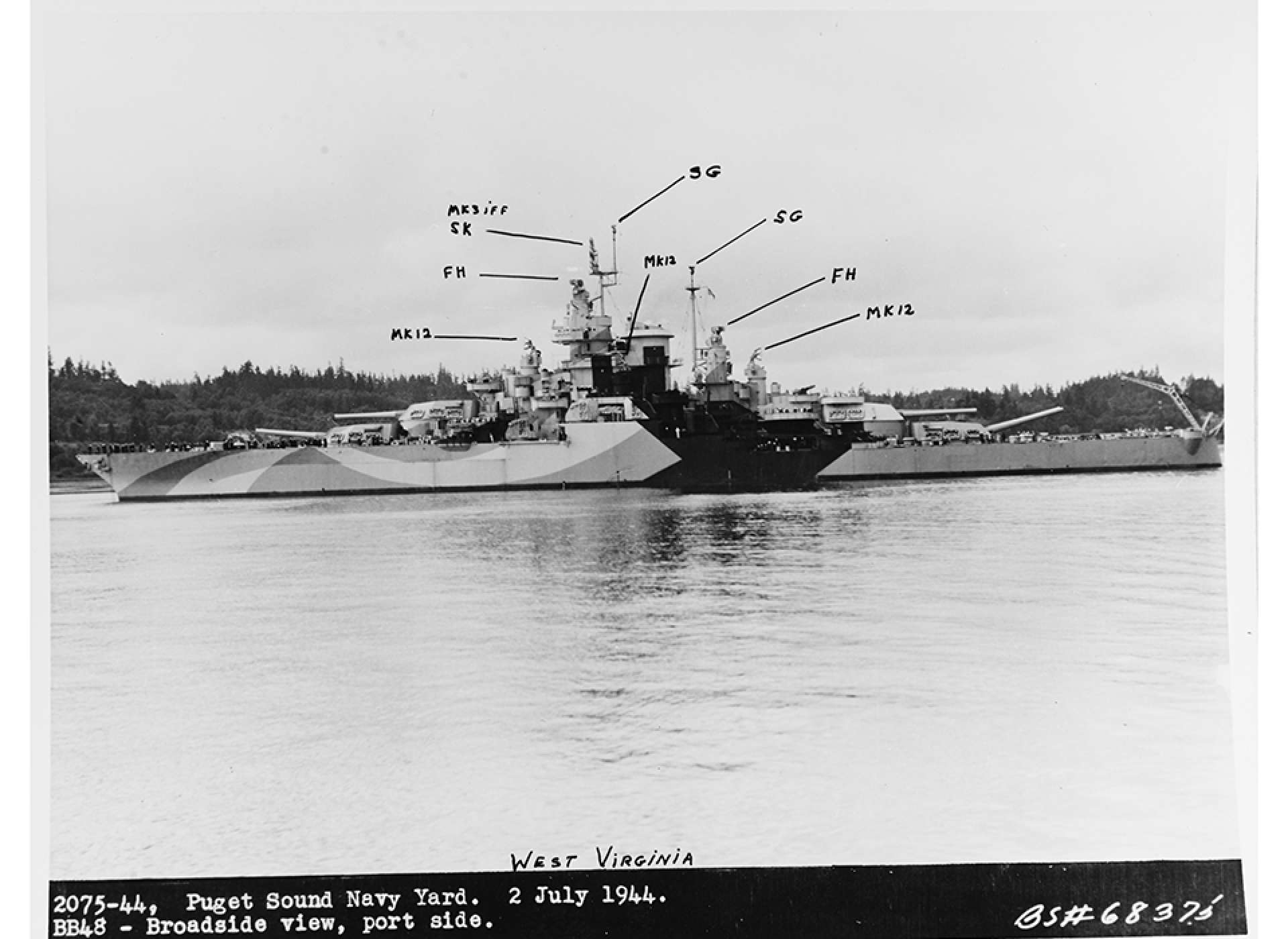
Details of the reconstruction for ONI, Puget Sound, summer 1944.
Philippines campaign
On 12 October 1944, USS West Virginia and BatDiv 4 headed for the Philippines, and Leyte. She joined Task Group (TG) 77.2, the main shore bombardment unit under Rear Admiral Jesse B. Oldendorf. As she headed astern of California, thelatter used its paravanes, which effectively cut the anchor chain of a naval mine. When spotted, it forced USS West Virginia to steer around it while destroyer gunfire detonated it. That was one of the case where Paravanes has been really helpful as Japanese minelayers has tranformed all approaches to leyte into giant minefields. TG 77.2 arrived in San Pedro Bay on 19 October after dawn. USS West Virginia took her bombardment position; She targeted Tacloban’s positions and covered the Underwater Demolition Teams in action the day before the invasion, and then withdrawing with the fleet to avoid coastal night actions. In total she fired 278 main shells, 1,586 rounds secondaries (5-in).
The Sixth Army went ashore the following day, USS West Virginia staying on station for close gunfire support. There was a first IJN air attack, and her state of the art AA battery started to bark, but the inexperiences gunners could not score a single plane. On 21 October underway to her newxt spot, USS West Virginia ran aground, damaging three propellers. Damaged blades caused vibrations so she was limited to 16 knots. She stayed on station for two days, providing on-demand fire support and providing AA defense as more attacks came.
Battle of Surigao Strait
Operation Shō-Gō 1 started soon, combining three separate fleets under Ozawa, Kurita, and Nishimura. Kurita’s ships were spotted in the San Bernardino Strait on 24 October 1944. USN aviation took off and during the Battle of the Sibuyan Sea, IJN Musashi was sunk. Admiral William F. Halsey (Third Fleet) went after the Northern Force, while Nishumura’s fleet entered the Surigao Strait to fall on Taffy 3, of the invasion fleet (Yamashiro, Fusō, Mogami, four destroyers and Shima’s Nachi, Ashigara, Abukuma, four destroyers. Nishimura’s flotilla was attacked during the night of 24-25 October by PT boats and destroyers (Battle of Surigao Strait). West Virginia, at the head of Oldenburg’s battleline spotted flashes in the distance and her radar at 03:02 picked up the ships at 44,000 yd (40,000 m) and again later at 42,000 yd (38,000 m). The battle line opened fire at 03:51, West Virginia, Tennessee and California in order, concentraing on IJN Yamashiro. West Virginia was later attributed a hit on Yamashiro’s bridge on her first salvo. The IJN Battleship was hit several times, badly damaged, before left for Mogami. At around 04:00, Mogami and Yamashiro, escorted by IJN Shigure tried to flee, with Oldendorf on their heels. West Virginia changed course at 04:02, still leading the line, running parallel to Yamashiro’s line of retreat for perfect spotting. Confusion aboard California however had her interfering with this, and the ships had to stop firing to avoid hitting her. However the chase stopped here after reports of Japanese torpedoes nearby. The line turned at 04:18, eding the battle. The Japanese managed to retreat in the darkness and eventually reached home, never to sail again. West Virginia in total fired sixteen salvos signing for the last battle between battleships in history.Later operations
On 29 October 1944, West Virginia, Tennessee and Maryland sailed to Ulithi to resupply and rest. The fleet headed for Espiritu Santo, West Virginia having her damaged propellers repaired in drydock.This was done in the floating drydock USS Artisan, followed by maintenance. She was back in November, stopping at Manus and the Leyte Gulf on 25 November. After patrols air attacks started at at 11:39 her gunners shot down their first kamikaze and assisted for several others. Admiral Ruddock made her her flagship again on 30 November. She departed on 2 December for the Palau Islands, making a replenishment and assigned as flagship of TG 77.12, the bombardment group for the main landings to follow.
The fleet was assembled in the Sulu Sea for the assault on Mindoro with the invasion fleet, TG 78.3. The landing took place and on 15 December the transports withdrew, escorted by West Virginia. She refueled in Leyte Gulf, headed for the Kossol Roads on 19 December. On 1st January 1945, Rear Admiral Ingram C. Sowell replaced Ruddock at the head of BatDiv 4. Joining TG 77.2 this unit entered Leyte Gulf on 3 January, went into the Sulu Sea to be on the 4 caught by heavy air attacks. USS Ommaney Bay (CVE) was badly damaged that day and latter abandoned, some sailores rescued by West Virginia.
On 5 January 1945, she with the rest of BatDiv 4 entered the South China Sea and headed for Lingayen Gulf, but under more Japanese air attacks. When she was off San Fernando Point, she shelled Japanese positions there. West Virginia managed to avoid any hit by a kamikaze the next days, and later rescued sailors from the sunken minesweeper USS Hovey. On 8–9 January, she shelled and razed the town of San Fabian (Lingayen Gulf) and covered the landing of the 9th. Fire support went on 10 January and she withdrew to patrol tne next week the Lingayen Gulf and create a defensive patrol line off the beachhead. She was also called to silenced Japanese positions in between. She also destroyed rail and road junctions, expendin 395 main battery shells, 2,800 secondary. On 21 January, she changed positions to offer close support during the reconquest of Rosario and Santo Tomas (north of Lingayen Gulf). TG 77.2 later covered transports carrying supplies at the beachhead and on 10 February, she departed for Leyte.
Battle of Iwo Jima
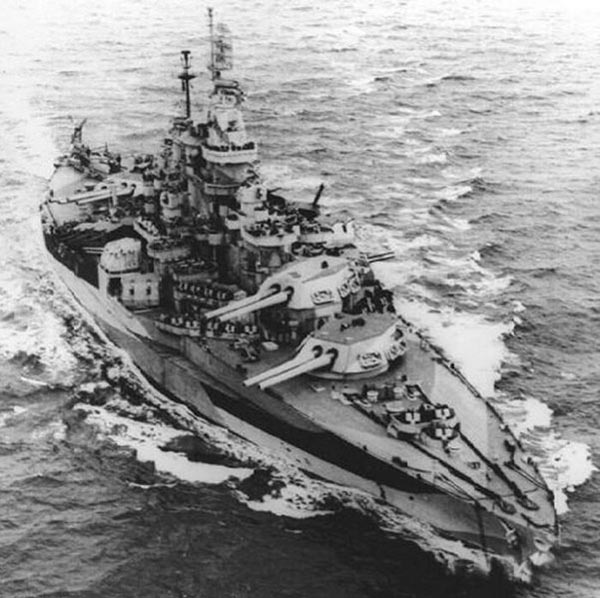
USS West Virginin 1944
West Virginia sailed through San Pedro Bay towards Ulithi, arriving on 16 February 1945. She met the Fifth Fleet and prepared for the upcoming assault on Iwo Jima. After refuellingr, loading ammunition complements, she departed during the night at 04:00 escorted by the destroyers USS Izard and McCall. She was on site on 19 February with TF 51. Bombardment commenced at 11:25 while she took her assigned station for the day 20 min later. She directly supported marines fighting ashore and withdrew for the evening. This routine went on again on 21 February, and that day she hit an ammunition or fuel dump, releasing multiple explosions for two hours. Small artillery shells fell on her the next day from Suribachi. She was hit near the forward superfiring turret. On 27 February, she silenced a Japanese artillery battery targeting USS Bryant. She left to replenish ammunition before starting sessions of night shellings in addition. When her mission was completed she departed for Ulithi on 4 March.
Battle of Okinawa
West Virginia teamed with Task Force 54 for the upcoming Ryukyu Islands Chain campaign, and departed on 21 March 1945. She arrived off Okinawa on 25 March and took her assigned bombardment station. She started shelling planned landing zones and on 26 March, a large Japanese shell fell about 4,600 m off her port bow, and she replied with 28 main rounds. Air counterattacks also started on the 28. Her now experienced AA gunns shot down a Yokosuka P1Y. She wen on with her preparatory shelling until the landing day on 1st April. Having replenished at Kerama Retto in between. Her anti-aircraft gunners spotted and shot down another aicraft and later West Viginia was targeted by four more, also destroyed. West Virginia made support fire all day, and remained off the island before retiring for the evening when a wave of kamikazes fell on the fleet at 19:03. One of them could not be shot down and crashed on USS West Virginia, hitting her superstructure forward of sec. battery No.2 director. This exposion claimed 4 lives and and 7 wounded. The bomb penetrated to the second deck but fortunately, failed to detonate and was later defused by the bomb disposal officer onboard.
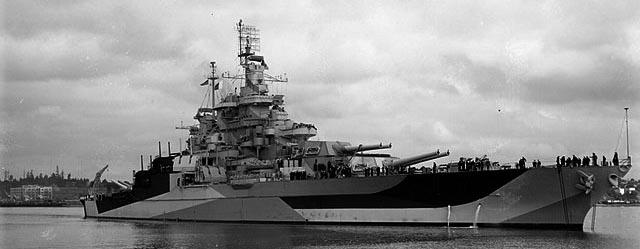
USS West Virginia 1944
USS West Virginia remained off Iwo Jima this night to provde more support, firing star shells to illuminate marine positions and repel Japanese infiltration attacks. On 6 April, her gunners shot down an Aichi D3A dive bomber and on 8 April, the Japanese Navy sent its last fleet, centered around battleship Yamato, on a suicide mission. West Virginia patrolled west of the island in interception while vigorous USN air attacks destroyed the icoming fleet. West Virginia resumed bombardments and AA defense until 20 April and was about to sail to Ulithi when she was recalled to replace her sister USS Colorado, badly damaged after an ammunition explosion. She stationed off Hagushi Beach, in direct support of the XXIV Corps, relieved and went to Ulithi with USS San Francisco (ii) and USS Hobson

USS West Virginia 1944
She was back to Okinawa until June. On 1-2 June, she destroyed an important Japanese blockhouse inland. On 16 June, she moved to support the 1st Marine Regiment, and one of her OS2U Kingfishers was shot down and the pilot and observer fell behind Japanese lines. West Virginia and her escort USS destroyer Putnam trie to suppress Japanese defenses her to have ground forces breaking through and rescuing the air crew but this failed. She went on until the end of June, and left for San Pedro Bay with USS Connolly, arriving on 1st July. There, she resplenished, refuelled, took new cremen on board, had the resting, loaded ammunition and started training for the expected invasion of Kyushu. But this never happened: After Hiroshima and Nagasaki, rumors spread on 10 August of a surrender, but crews were recalled to reality when learning that USS Pennsylvania was torpedoed by a Japanese submarine off Okinawa.
Post war
On 15 August, the surrender was now official. West Virginia’s marines prepared for the occupation of Japan and she departed on 24 August for Tokyo Bay, to serve with TG 35.90. She arrived on 31 August and was thus present for the surrender ceremonies aboard USS Missouri on 2 September. BB-48 remained in Tokyo for two weeks and carried on 14 September 270 passengers back to the United States. She departed on 20 September with TG 30.4 for Okinawa, stopped in Buckner Bay (23 September) then in Pearl Harbor (4 October) to stay a while. She was repainted and sailed again on 9 October, heading for San Diego, California, arriving on 22 October. She had ben was awarded “only” five battle stars due to her shorter career.
Sge participated in Navy Day celebrations on 27 October 1945, and hosted 25,554 visits that day. She departed for Pearl Harbor and started runs for Operation Magic Carpet between there and San Diego, making three runs until 17 December. On 4 January 1946 she departed for Bremerton and was taken in hands for deactivation, which was done in “battleship park” in Seattle, Washington. She was tied up there alongside her sister ship USS Colorado. Preservation work was done for her to be in the reserve fleet from February 1946, and formal decommission on 9 January 1947, for the Pacific Reserve Fleet. She stayld listed until 1 March 1959, then struck from the Register, and sold on 24 August (Union Minerals & Alloys Corp), towed to Todd-Pacific Shipyard (Seattle) on 3 January 1961 for BU.
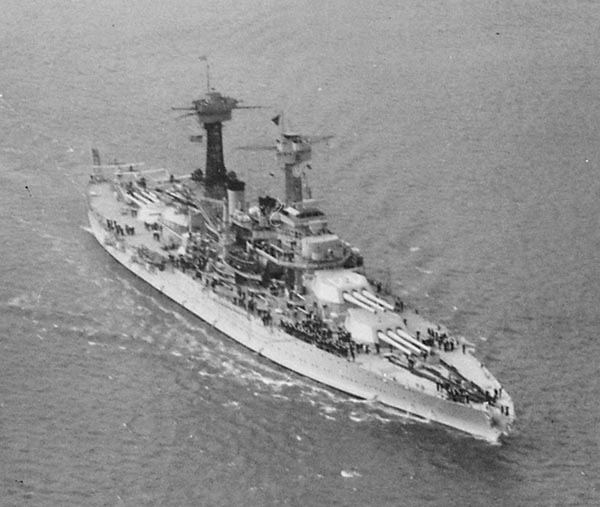
West_Virginia_Aerial_port_bow_underway_close
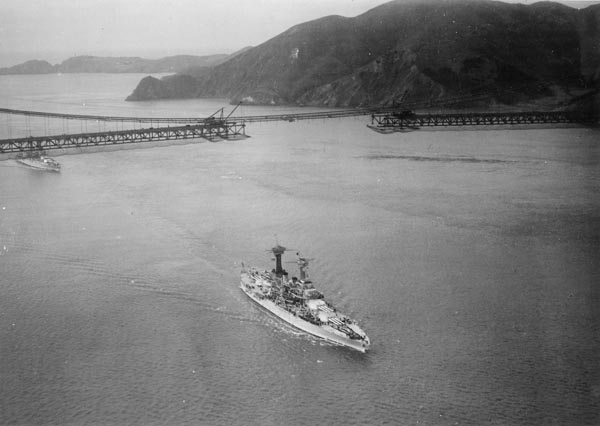
West_Virginia_Aerial_port_bow_underway

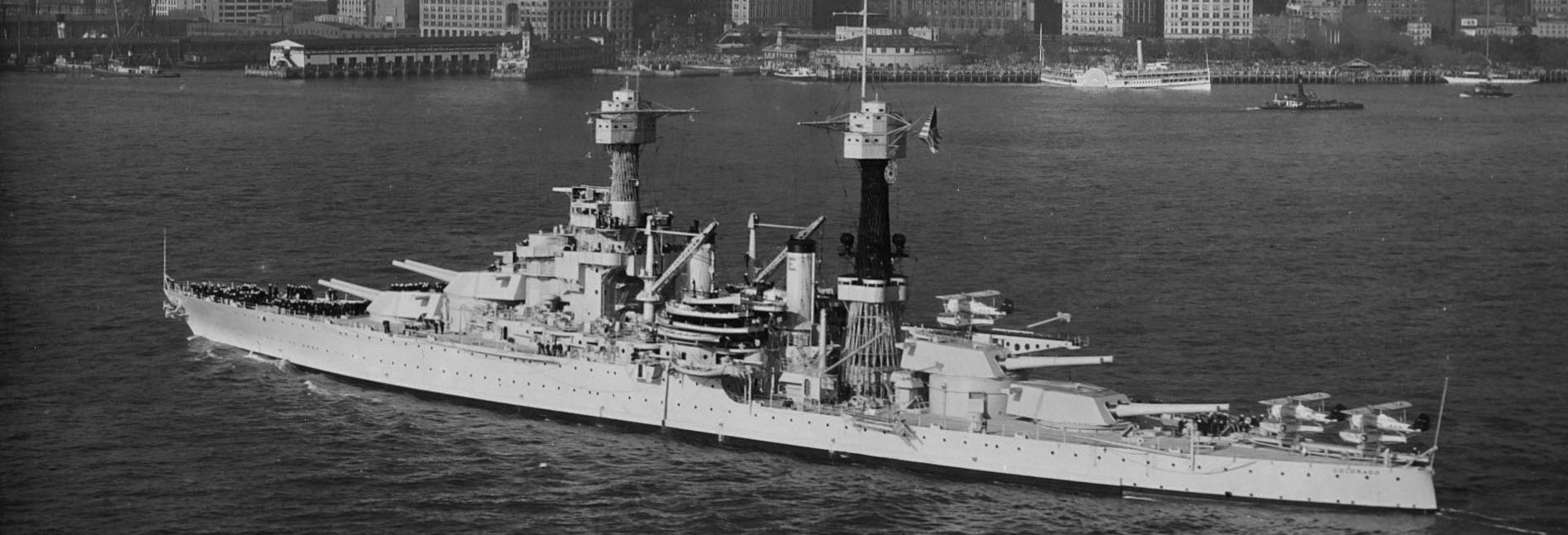

 Latest Facebook Entry -
Latest Facebook Entry -  X(Tweeter) Naval Encyclopedia's deck archive
X(Tweeter) Naval Encyclopedia's deck archive Instagram (@navalencyc)
Instagram (@navalencyc)





 French Navy
French Navy Royal Navy
Royal Navy Russian Navy
Russian Navy Armada Espanola
Armada Espanola Austrian Navy
Austrian Navy K.u.K. Kriegsmarine
K.u.K. Kriegsmarine Dansk Marine
Dansk Marine Nautiko Hellenon
Nautiko Hellenon Koninklije Marine 1870
Koninklije Marine 1870 Marinha do Brasil
Marinha do Brasil Osmanlı Donanması
Osmanlı Donanması Marina Do Peru
Marina Do Peru Marinha do Portugal
Marinha do Portugal Regia Marina 1870
Regia Marina 1870 Nihhon Kaigun 1870
Nihhon Kaigun 1870 Preußische Marine 1870
Preußische Marine 1870 Russkiy Flot 1870
Russkiy Flot 1870 Svenska marinen
Svenska marinen Søværnet
Søværnet Union Navy
Union Navy Confederate Navy
Confederate Navy Armada de Argentina
Armada de Argentina Imperial Chinese Navy
Imperial Chinese Navy Marinha do Portugal
Marinha do Portugal Mexico
Mexico Kaiserliche Marine
Kaiserliche Marine 1898 US Navy
1898 US Navy Sovietskiy Flot
Sovietskiy Flot Royal Canadian Navy
Royal Canadian Navy Royal Australian Navy
Royal Australian Navy RNZN Fleet
RNZN Fleet Chinese Navy 1937
Chinese Navy 1937 Kriegsmarine
Kriegsmarine Chilean Navy
Chilean Navy Danish Navy
Danish Navy Finnish Navy
Finnish Navy Hellenic Navy
Hellenic Navy Polish Navy
Polish Navy Romanian Navy
Romanian Navy Turkish Navy
Turkish Navy Royal Yugoslav Navy
Royal Yugoslav Navy Royal Thai Navy
Royal Thai Navy Minor Navies
Minor Navies Albania
Albania Austria
Austria Belgium
Belgium Columbia
Columbia Costa Rica
Costa Rica Cuba
Cuba Czechoslovakia
Czechoslovakia Dominican Republic
Dominican Republic Haiti
Haiti Hungary
Hungary Honduras
Honduras Estonia
Estonia Iceland
Iceland Eire
Eire Equador
Equador Iran
Iran Iraq
Iraq Latvia
Latvia Liberia
Liberia Lithuania
Lithuania Mandchukuo
Mandchukuo Morocco
Morocco Nicaragua
Nicaragua Persia
Persia San Salvador
San Salvador Sarawak
Sarawak Uruguay
Uruguay Venezuela
Venezuela Zanzibar
Zanzibar Warsaw Pact Navies
Warsaw Pact Navies Bulgaria
Bulgaria Hungary
Hungary

 Bundesmarine
Bundesmarine Dutch Navy
Dutch Navy Hellenic Navy
Hellenic Navy Marina Militare
Marina Militare Yugoslav Navy
Yugoslav Navy Chinese Navy
Chinese Navy Indian Navy
Indian Navy Indonesian Navy
Indonesian Navy JMSDF
JMSDF North Korean Navy
North Korean Navy Pakistani Navy
Pakistani Navy Philippines Navy
Philippines Navy ROKN
ROKN Rep. of Singapore Navy
Rep. of Singapore Navy Taiwanese Navy
Taiwanese Navy IDF Navy
IDF Navy Saudi Navy
Saudi Navy Royal New Zealand Navy
Royal New Zealand Navy Egyptian Navy
Egyptian Navy South African Navy
South African Navy






























 Ukrainian Navy
Ukrainian Navy dbodesign
dbodesign